Senao Networks OC1650 Wireless AP/CB User Manual EOC1650 UsersManual 20090701
Senao Networks, Inc. Wireless AP/CB EOC1650 UsersManual 20090701
manual
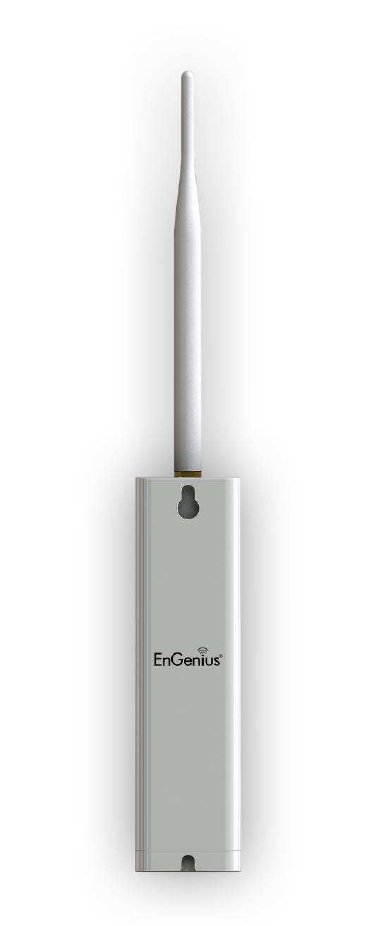
Wireless
Access Point & Client Bridge
User’s Manual
Version: 1.1

Long Range Wireless Access Point / Client Bridge Version 1.0
2
Table of Contents
1
INTRODUCTION............................................................................................................................... 5
1.1
F
EATURES
.................................................................................................................................... 5
1.2
P
ACKAGE
C
ONTENTS
................................................................................................................... 6
1.3
S
AFETY
G
UIDELINES
.................................................................................................................... 6
1.4
S
YSTEM
R
EQUIREMENTS
.............................................................................................................. 6
1.5
A
PPLICATIONS
.............................................................................................................................. 7
2
UNDERSTANDING THE HARDWARE.......................................................................................... 8
2.1
H
ARDWARE
I
NSTALLATION
.......................................................................................................... 8
2.2
H
ARDWARE
D
ESCRIPTION
............................................................................................................ 8
2.3
M
OUNTING
K
ITS
.......................................................................................................................... 9
2.4
IP
A
DDRESS
C
ONFIGURATION
...................................................................................................... 9
3
SWITCHING BETWEEN OPERATING MODES ........................................................................11
3.1
L
OGGING
I
N
................................................................................................................................11
4
ACCESS POINT OPERATING MODE ......................................................................................... 12
L
OGGING
I
N
.............................................................................................................................................. 12
S
TATUS
..................................................................................................................................................... 13
M
AIN
........................................................................................................................................................ 13
W
IRELESS
C
LIENT
L
IST
............................................................................................................................ 14
S
YSTEM
L
OG
............................................................................................................................................ 14
S
YSTEM
.................................................................................................................................................... 15
S
YSTEM
P
ROPERTIES
................................................................................................................................ 15
IP
S
ETTINGS
............................................................................................................................................. 15
S
PANNING
T
REE
S
ETTINGS
....................................................................................................................... 16
W
IRELESS
................................................................................................................................................. 17
W
IRELESS
N
ETWORK
................................................................................................................................ 17
W
IRELESS
S
ECURITY
-
WEP..................................................................................................................... 17
W
IRELESS
S
ECURITY
–
WPA-PSK,
WPA2-PSK,
WPA-M
IXED
............................................................... 18
W
IRELESS
S
ECURITY
–
WPA,
WPA2 ....................................................................................................... 19
W
IRELESS
MAC
F
ILTER
........................................................................................................................... 20
W
IRELESS
A
DVANCED
S
ETTINGS
............................................................................................................. 21
M
ANAGEMENT
......................................................................................................................................... 22
A
DMINISTRATION
..................................................................................................................................... 22
SNMP
S
ETTINGS
...................................................................................................................................... 22
B
ACKUP
/R
ESTORE SETTINGS
,
R
ESET TO FACTORY DEFAULT SETTINGS
.................................................... 23
F
IRMWARE
U
PGRADE
............................................................................................................................... 24
T
IME
S
ETTINGS
......................................................................................................................................... 25
L
OG
.......................................................................................................................................................... 25
5
CLIENT BRIDGE OPERATING MODE....................................................................................... 26
5.1
L
OGGING
I
N
............................................................................................................................... 26
5.2
S
TATUS
...................................................................................................................................... 27
5.2.1
M
AIN
.......................................................................................................................................... 27
5.2.2
C
ONNECTION
S
TATUS
................................................................................................................ 28
5.2.3
S
YSTEM
L
OG
.............................................................................................................................. 28
5.3
S
YSTEM
...................................................................................................................................... 29
5.3.1
S
YSTEM
P
ROPERTIES
.................................................................................................................. 29
5.3.2
IP
S
ETTINGS
............................................................................................................................... 29
5.3.3
S
PANNING
T
REE
S
ETTINGS
......................................................................................................... 30
5.4
W
IRELESS
.................................................................................................................................. 31

Long Range Wireless Access Point / Client Bridge Version 1.0
3
5.4.1
W
IRELESS
N
ETWORK
................................................................................................................. 31
5.4.2
W
IRELESS
S
ECURITY
-
WEP ...................................................................................................... 32
5.4.3
W
IRELESS
S
ECURITY
–
WPA-PSK,
WPA2-PSK,....................................................................... 33
5.4.4
W
IRELESS
A
DVANCED
S
ETTINGS
............................................................................................... 33
5.5
M
ANAGEMENT
........................................................................................................................... 34
5.5.1
A
DMINISTRATION
....................................................................................................................... 34
5.5.2
SNMP
S
ETTINGS
........................................................................................................................ 35
5.5.3
B
ACKUP
/R
ESTORE SETTINGS
,
R
ESET TO FACTORY DEFAULT SETTINGS
...................................... 35
5.5.4
F
IRMWARE
U
PGRADE
................................................................................................................. 36
5.5.5
T
IME
S
ETTINGS
.......................................................................................................................... 37
5.5.6
L
OG
............................................................................................................................................ 37
6
CLIENT ROUTER OPERATING MODE ..................................................................................... 39
6.1
L
OGGING
I
N
............................................................................................................................... 39
6.2
S
TATUS
...................................................................................................................................... 40
6.2.1
M
AIN
.......................................................................................................................................... 40
6.2.2
C
ONNECTION
S
TATUS
................................................................................................................ 41
6.2.3
S
YSTEM
L
OG
.............................................................................................................................. 41
6.3
S
YSTEM
...................................................................................................................................... 42
6.3.1
S
YSTEM
P
ROPERTIES
.................................................................................................................. 42
6.4
R
OUTER
...................................................................................................................................... 42
6.4.1
WAN
S
ETTINGS
......................................................................................................................... 42
6.4.1.1
WAN
-
DHCP ....................................................................................................................... 43
6.4.1.2
WAN
–
S
TATIC
IP ................................................................................................................. 44
6.4.1.3
WAN
–
PPP
O
E...................................................................................................................... 45
6.4.2
VPN
P
ASS
T
HROUGH
................................................................................................................. 46
6.5
W
IRELESS
.................................................................................................................................. 46
6.5.1
W
IRELESS
N
ETWORK
................................................................................................................. 46
6.5.1.1
W
IRELESS
S
ECURITY
-
WEP.................................................................................................. 47
6.5.1.2
W
IRELESS
S
ECURITY
–
WPA-PSK,
WPA2-PSK,.................................................................. 48
6.5.2
W
IRELESS
A
DVANCED
S
ETTINGS
............................................................................................... 49
6.6
M
ANAGEMENT
........................................................................................................................... 50
5.5.7
A
DMINISTRATION
....................................................................................................................... 50
5.5.8
SNMP
S
ETTINGS
........................................................................................................................ 51
5.5.9
B
ACKUP
/R
ESTORE SETTINGS
,
R
ESET TO FACTORY DEFAULT SETTINGS
...................................... 51
5.5.10
F
IRMWARE
U
PGRADE
............................................................................................................ 52
5.5.11
T
IME
S
ETTINGS
...................................................................................................................... 53
5.5.12
L
OG
....................................................................................................................................... 53
APPENDIX A – FCC INTERFERENCE STATEMENT........................................................................ 55
APPENDIX B – IC STATEMENT............................................................................................................ 56

Long Range Wireless Access Point / Client Bridge Version 1.0
4
Revision History
Version Date Notes
1.0 August 24, 2008 Initial Version

Long Range Wireless Access Point / Client Bridge Version 1.0
5
1 Introduction
EOC1650 is a long range outdoor wireless Access Point and Client Bridge that operates
seamlessly in the 2.4GHz frequency spectrum. It features high transmitted output power
and high receivable sensitivity. High output power and high sensitivity can extend range
and coverage to reduce the roaming between Access Points to get a more stable
wireless connection. It also reduces the expense of equipment in the same environment.
It supports distance range from 1km to 30km and RSSI indicator which enables the best
transmit and receive signals for traffic communication. This product comes with PoE
injector for building in outdoor environment easily.
To protect your wireless connectivity, it can encrypt all wireless transmissions through
64/128-bit WEP data encryption and also supports WPA/WPA2. The MAC address filter
lets you select exactly which stations should have access to your network. In addition,
the User Isolation function can protect the private network between client users.
The attractive design, high performance, and array of features make EOC1650 a suitable
wireless solution for your residence or office.
This chapter describes the features, package contents, applications, and network
configuration.
1.1 Features
Wireless
• 2.4GHz It works in 2.4GHz frequency spectrum
• High output power Transmit output power programmable for long range
application
• High Data Rate High speed transmitting rate up to 54Mbps, support large
payload such as MEPG video streaming
• Multifunction application Access Point/Client Bridge/Client Router
• Long range transmitting Transmit power control and distance control (ACK
timeout)
• Signal Strength LED indicators have the best transmit and receive signal for
traffic communication
Networking
• Public wireless solution An AP interface that is especially useful in public
areas such as hotspots and enterprise
• Signal Strength Display RF signal strength status shown LEDs of 3 colors,
making network build-up easier
• QoS(WMM) Enhance performance and quality of service
Security
• 802.11i WEP, WPA, WPA2 (Encryption support TKIP/AES)

Long Range Wireless Access Point / Client Bridge Version 1.0
6
• 802.1x IEEE 802.1x Authenticator
• MAC address functions MAC address filter (AP mode)
• Station isolation
Management
• Firmware Upgrade Upgrading firmware via web browser, setting are reserved
after upgrade
• Reset & Backup Reset to factory default. User can export all setting into a file
via WEB
• MIB MIB I, MIB II(RFC1213)
• SNMP V1, V2c
1.2 Package Contents
Open the package carefully, and make sure that none of the items listed below are
missing. Do not discard the packing materials, in case of return; the unit must be shipped
in its original package.
1* 802.11b/g Long range AP/CB (EOC1650)
1* PoE injector (EPE-1212)
1* Power Adaptor
1* CD with User’s Manual
1* Quick Installation Guide (QIG)
1* Metal Strap
2* Special Screw Set (Screw size : 3φ x 16.5mm)
1* 5dBi Dipole Antenna
2* Suction Cup
1.3 Safety Guidelines
In order to reduce the risk of fire, electric shock and injury, please adhere to the following
safety guidelines.
Carefully follow the instructions in this manual; also follow all instruction labels
on this device.
Except for the power adapter supplied, this device should not be connected to
any other adapters.
Do not spill liquid of any kind on this device.
Do not place the unit on an unstable stand or table. This unit may drop and
become damaged.
Do not place any hot devices close to this unit, as they may degrade or cause
damage to the unit.
Do not place any heavy objects on top of this unit.
Do not use liquid cleaners or aerosol cleaners. Use a soft dry cloth for cleaning.
1.4 System Requirements
The following are the minimum system requirements in order configure the device.

Long Range Wireless Access Point / Client Bridge Version 1.0
7
PC/AT compatible computer with an Ethernet interface.
Operating system that supports HTTP web-browser
1.5 Applications
The wireless LAN products are easy to install and highly efficient. The following list
describes some of the many applications made possible through the power and flexibility
of wireless LANs:
a) Difficult-to-wire environments
There are many situations where wires cannot be laid easily. Historic
buildings, older buildings, open areas and across busy streets make the
installation of LANs either impossible or very expensive.
b) Temporary workgroups
Consider situations in parks, athletic arenas, exhibition centers, disaster-
recovery, temporary offices and construction sites where one wants a
temporary WLAN established and removed.
c) The ability to access real-time information
Doctors/nurses, point-of-sale employees, and warehouse workers can
access real-time information while dealing with patients, serving customers
and processing information.
d) Frequently changed environments
Show rooms, meeting rooms, retail stores, and manufacturing sites where
frequently rearrange the workplace.
e) Small Office and Home Office (SOHO) networks
SOHO users need a cost-effective, easy and quick installation of a small
network.
f) Wireless extensions to Ethernet networks
Network managers in dynamic environments can minimize the overhead
caused by moves, extensions to networks, and other changes with wireless
LANs.
g) Wired LAN backup
Network managers implement wireless LANs to provide backup for mission-
critical applications running on wired networks.
h) Training/Educational facilities
Training sites at corporations and students at universities use wireless
connectivity to ease access to information, information exchanges, and
learning.
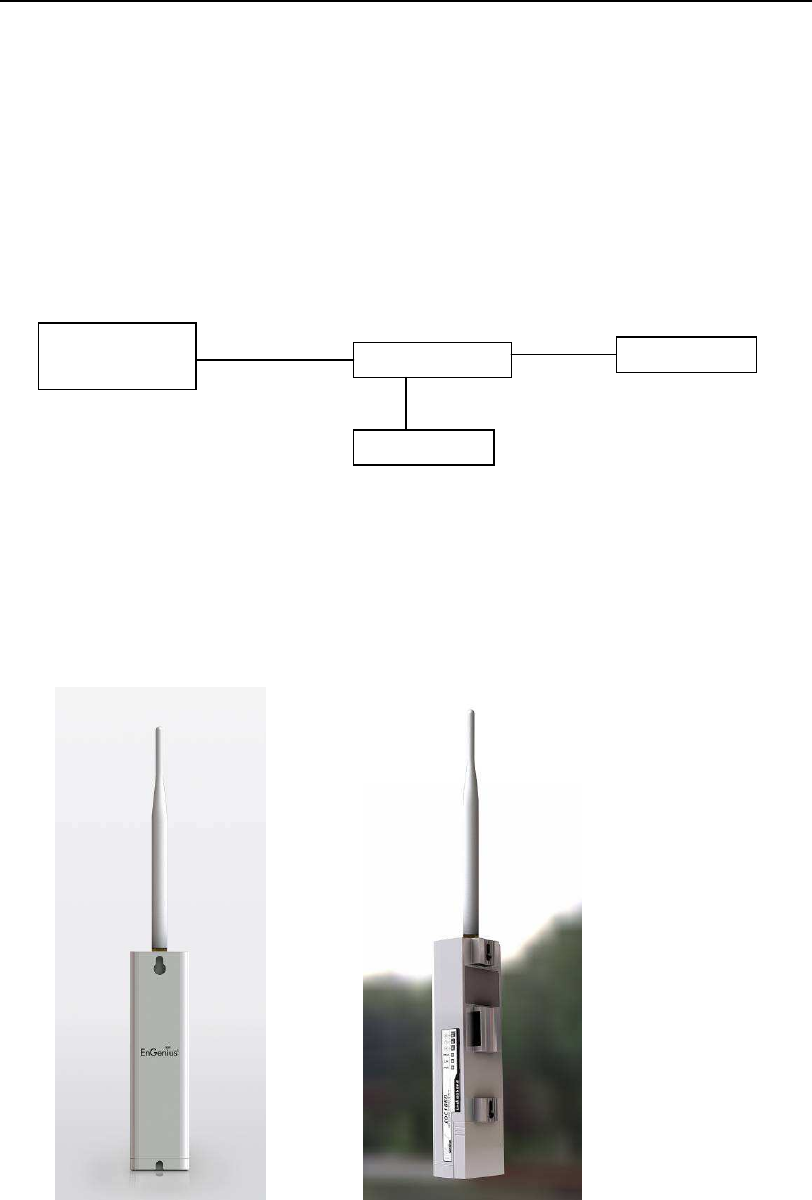
2 Understanding the Hardware
2.1 Hardware Installation
1. Place the unit in an appropriate location after conducting a site survey.
2. Plug one end of the Ethernet cable into the Network port of the PoE injector and
another end into your PC/Notebook.
3. Plug one end of another Ethernet cable to AP/Bridge port of the PoE injector and the
other end into you cable/DSL modem (Internet)
4. Insert the DC-inlet of the power adapter into the 24V port of the PoE injector and the
other end into the power socket on the wall.
This diagram depicts the hardware configuration
2.2 Hardware Description
The images below depict the front and rear panel of the Access Point / Client Bridge.
PoE Injector
PC, Cable/DSL
Modem
Power Outlet
Ethernet
AC/DC cable
Ethernet
Access Point
Front Panel
Rear Panel
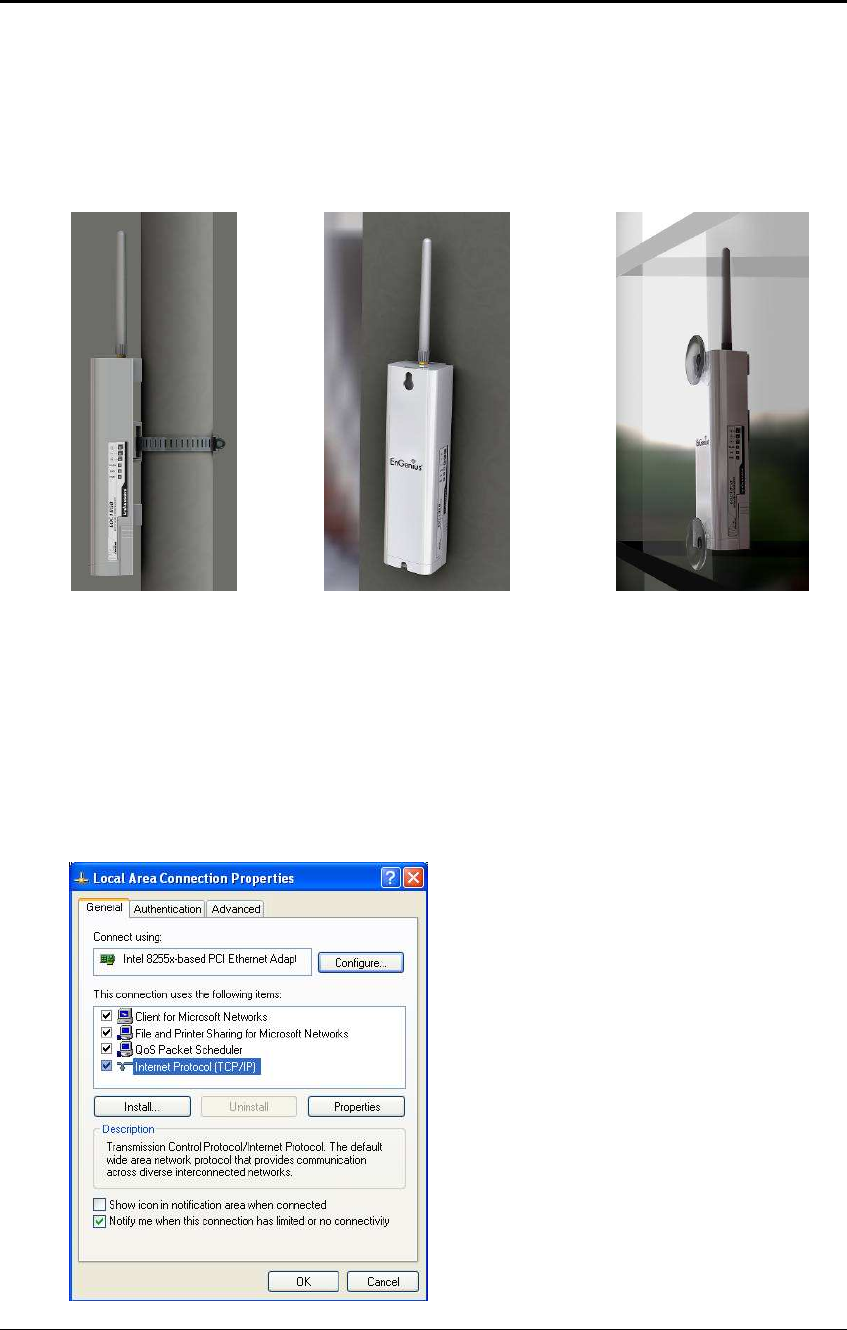
Long Range Wireless Access Point / Client Bridge Version 1.0
9
2.3 Mounting Kits
The images below depict the standard mounting kits.
2.4 IP Address Configuration
This device can be configured as a Bridge/Router or Access Point. The default IP
address of the device is 192.168.1.1 In order to log into this device, you must first
configure the TCP/IP settings of your PC/Notebook.
1. In the control panel, double click Network Connections and then double click on the
connection of your Network Interface Card (NIC). You will then see the following
screen.
Pole Mount
Wall Mount
Window Mount
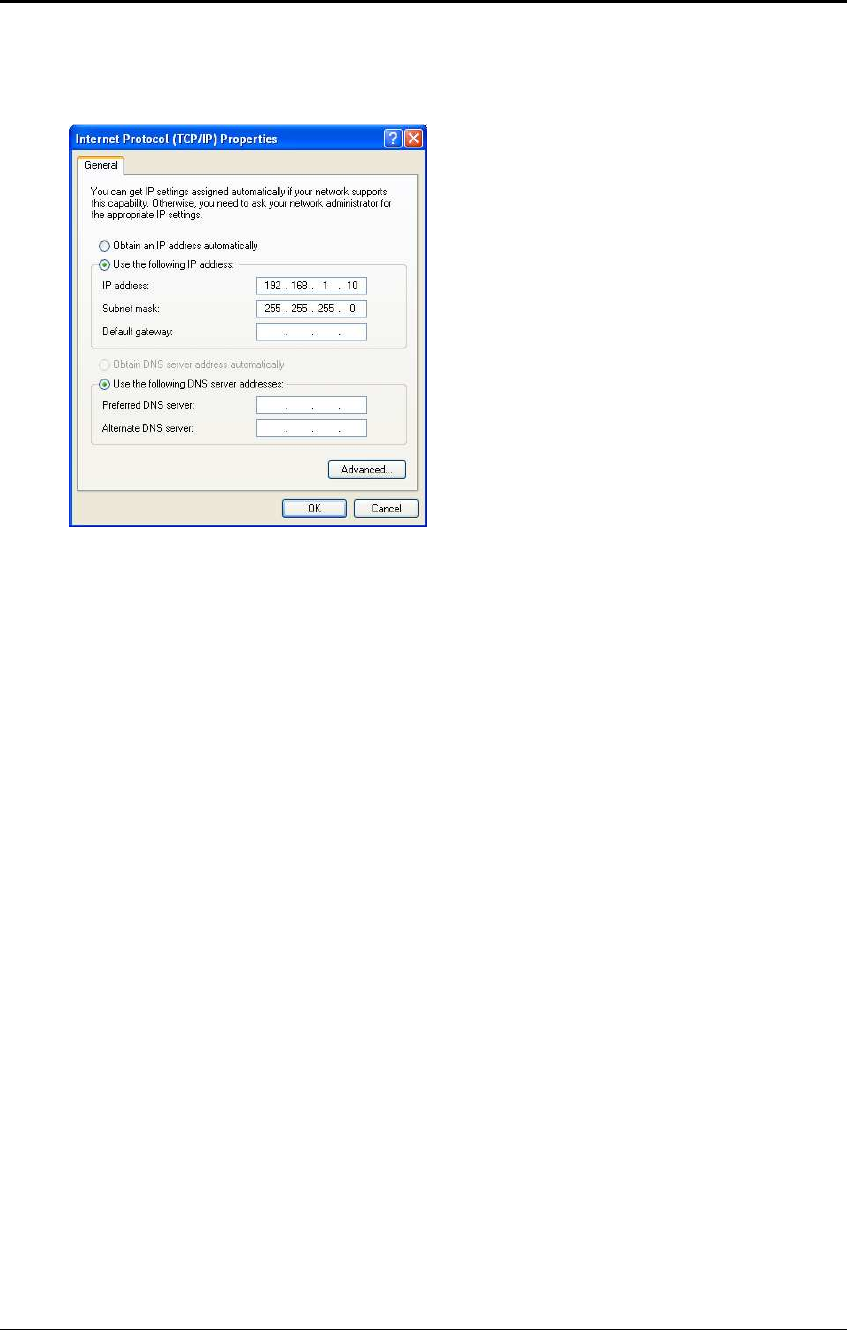
Long Range Wireless Access Point / Client Bridge Version 1.0
10
2. Select Internet Protocol (TCP/IP) and then click on the Properties button. This will
allow you to configure the TCP/IP settings of your PC/Notebook.
3. Select Use the following IP Address radio button and then enter the IP address
and subnet mask. Ensure that the IP address and subnet mask are on the same
subnet as the device.
For Example:
PC IP address: 192.168.1.10
PC subnet mask: 255.255.255.0
4. Click on the OK button to close this window, and once again to close LAN properties
window.
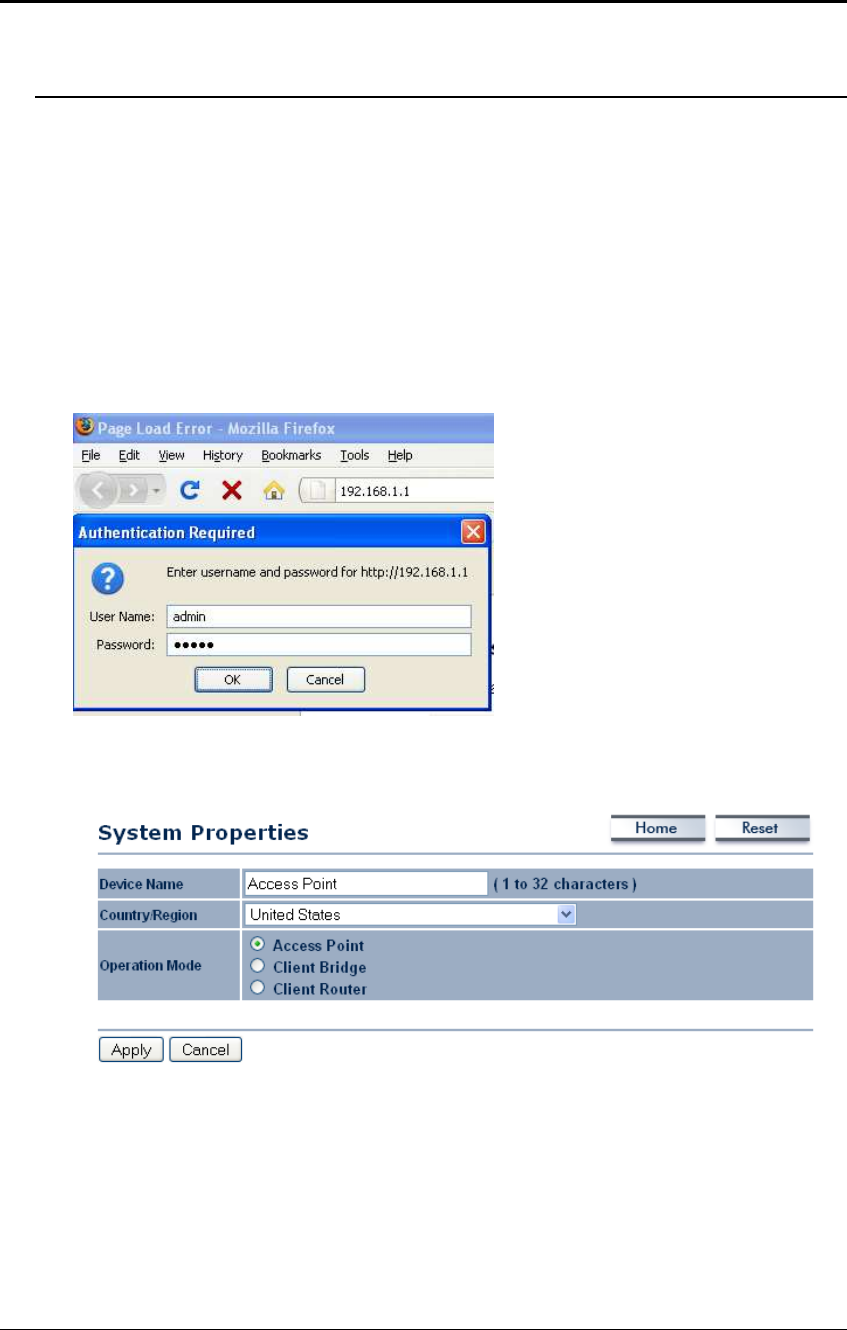
Long Range Wireless Access Point / Client Bridge Version 1.0
11
3 Switching Between Operating Modes
This device can operate in three modes: Access Point, Client t Bridge, and Client Router.
This chapter will describe how to switch between operating modes.
3.1 Logging In
To configure the device through the web-browser, enter the IP address of the device
(default: 192.168.1.1) into the address bar of the web-browser and press Enter.
Make sure that the device and your computers are configured on the same subnet.
Refer to Chapter 2 in order to configure the IP address of your computer.
After connecting to the IP address, the web-browser will display the login page.
Specify admin for both the user name and password.
After logging in, you will see the graphical user interface of the device. Click on the
System Properties link under the System navigation drop-down menu.
Select and operating mode from the list (Access Point, Client Bridge, or Client Router)
and then click on the Apply button.
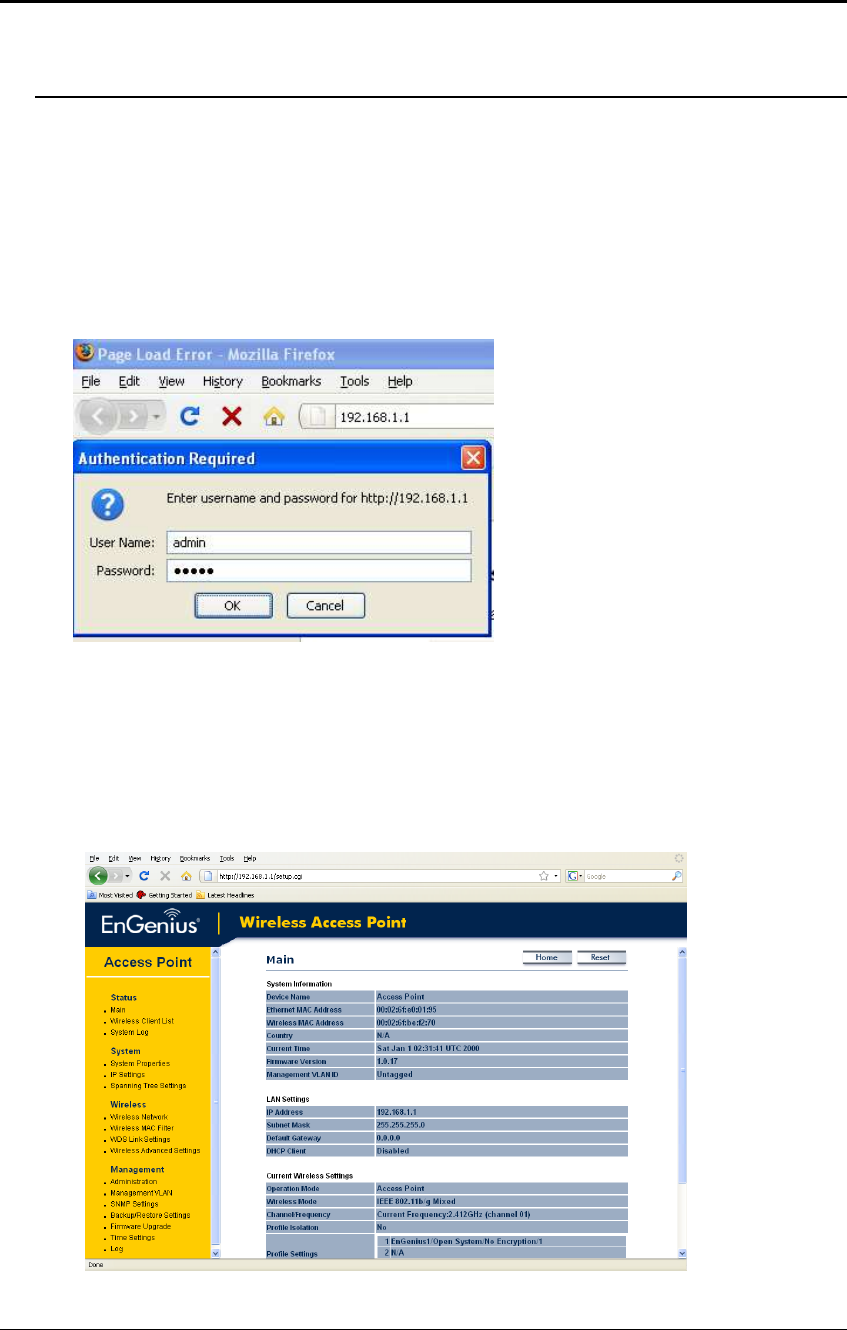
Long Range Wireless Access Point / Client Bridge Version 1.0
12
4 Access Point Operating Mode
Logging In
To configure the device through the web-browser, enter the IP address of the device
(default: 192.168.1.1) into the address bar of the web-browser and press Enter.
Make sure that the device and your computers are configured on the same subnet.
Refer to Chapter 2 in order to configure the IP address of your computer.
After connecting to the IP address, the web-browser will display the login page.
Specify admin for both the user name and password.
After logging in you will graphical user interface (GUI) of the device. The navigation
drop-down menu on left is divided into four sections:
1. Status: Displays the overall status, connection status, and event log.
2. System: This menu includes the system properties, IP and Spanning Tree settings.
3. Wireless: This menu includes status, basic, advanced, and security.
4. Management: This menu includes the admin setup, SNMP, firmware upgrade, and
save/restore backup.
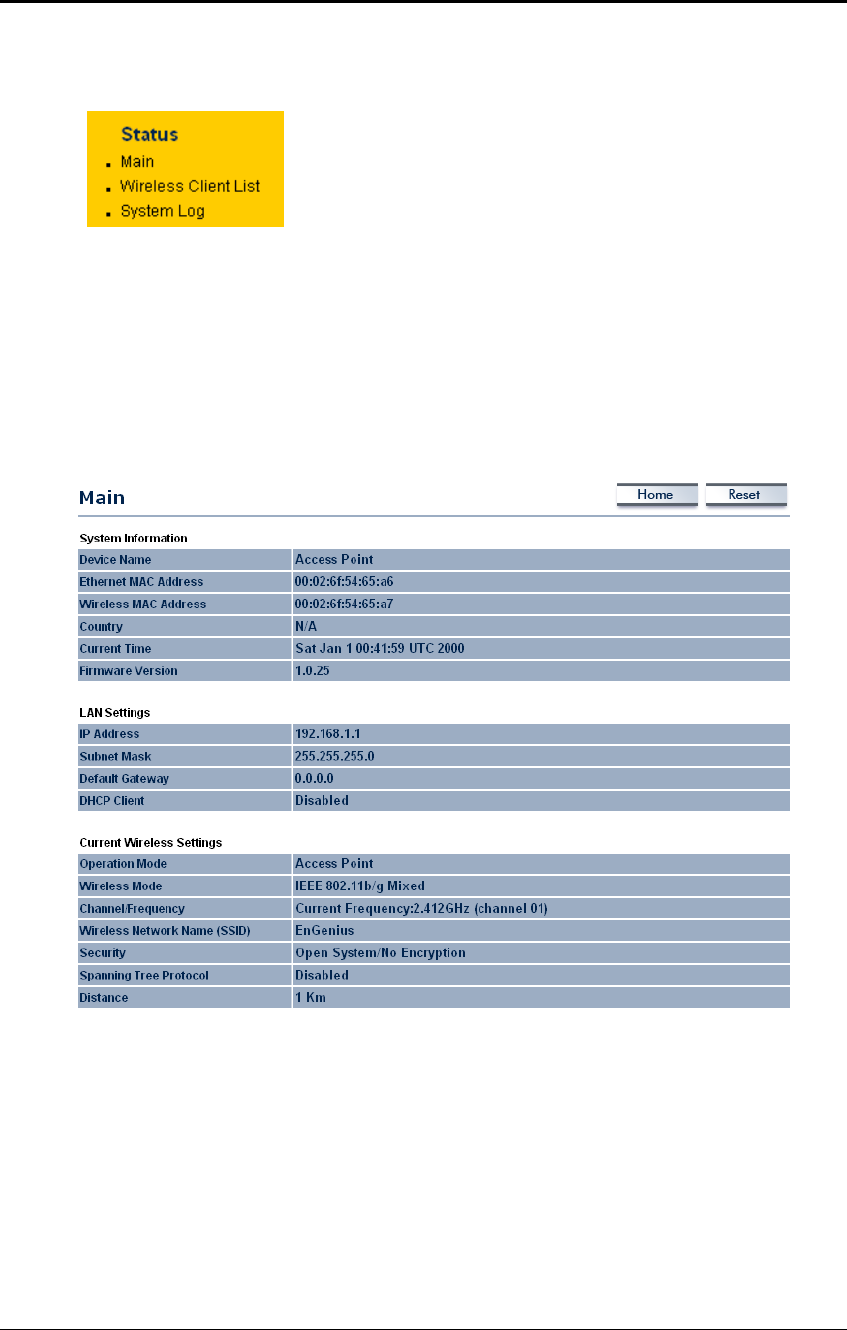
Long Range Wireless Access Point / Client Bridge Version 1.0
13
Status
Click on the Status link on the navigation drop-
down menu. You will then see three options: Main,
Wireless Client List, and System Log. Each option is
described in detail below.
Main
Click on the Main link under the Status drop-down menu. The status that is
displayed corresponds with the operating mode that is selected. Information such as
system up time, firmware version, serial number, kernel version and application
version are displayed in the ‘System’ section. LAN IP address, subnet mask, and
MAC address are displayed in the ‘System’ section. In the ‘Wireless section, the
frequency, channel is displayed.
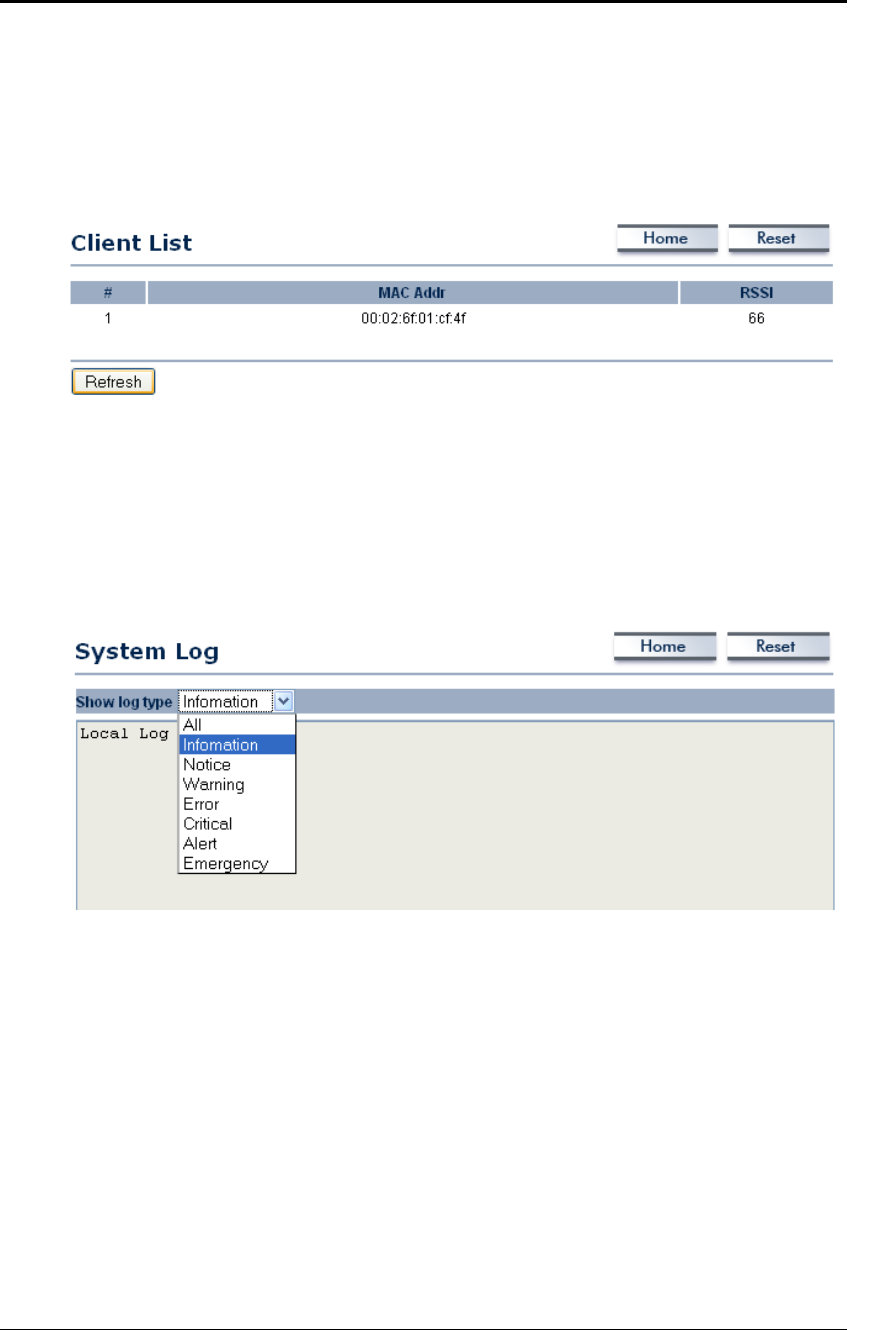
Long Range Wireless Access Point / Client Bridge Version 1.0
14
Wireless Client List
Click on the Wireless Client List link under the Status drop-down menu. This page
displays the list of Clients that are associated to the Access Point.
The MAC addresses and signal strength for each client is displayed. Click on the
Refresh button to refresh the client list
System Log
Click on the System Log link under the Status drop-down menu. The device
automatically logs (records) events of possible interest in its internal memory. If there
is not enough internal memory for all events, logs of older events are deleted, but
logs of the latest events are retained.
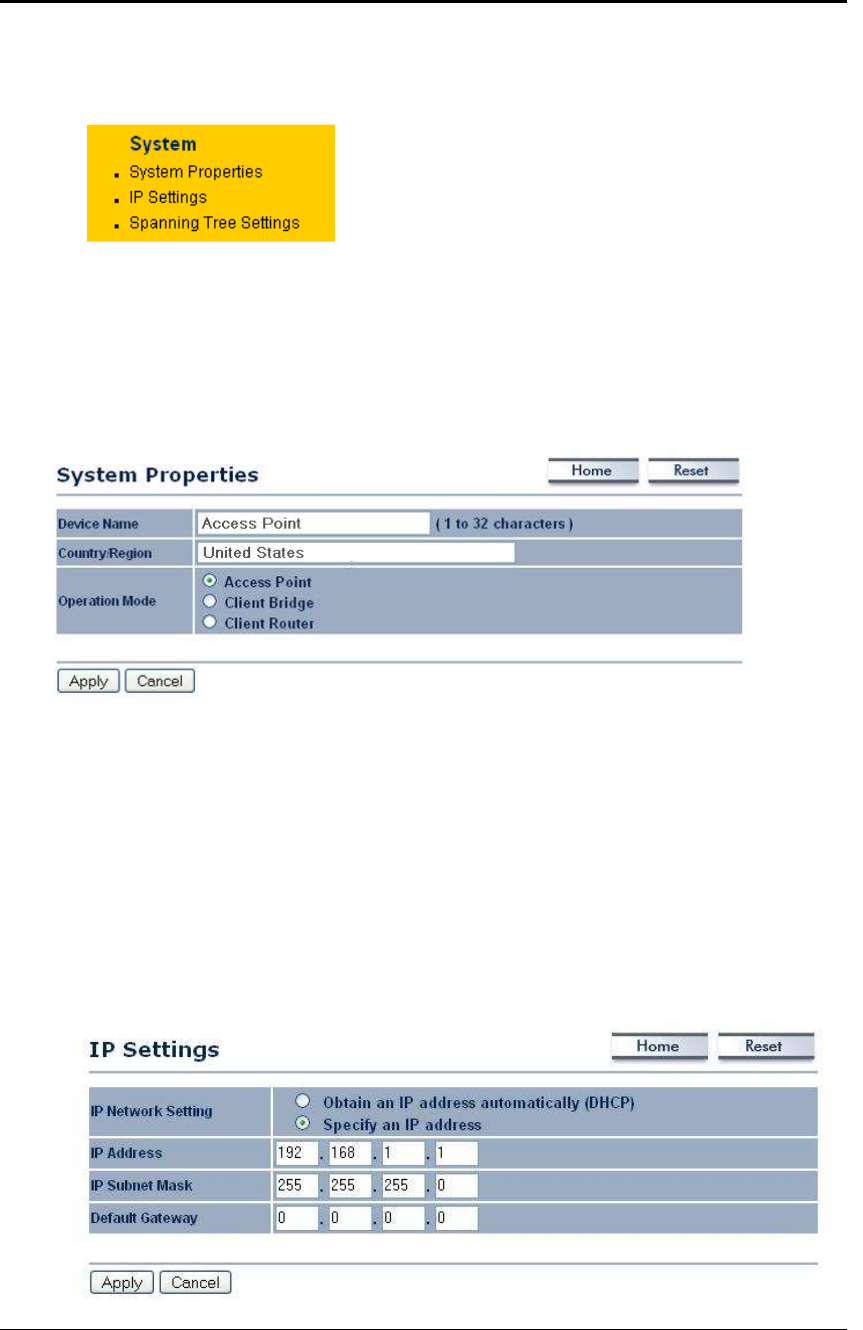
Long Range Wireless Access Point / Client Bridge Version 1.0
15
System
Click on the System link on the navigation
drop-down menu. You will then see three
options: System Properties, IP Settings, and
Spanning Tree Settings. Each option is
described in detail below.
System Properties
Click on the System Properties link under the System drop-down menu. This page
allows you to switch the operating mode of the device, as well as specify a name and
select the operating region.
Device Name: Specify a name for the device (this is not the SSID),
Country/Region: United States.
Operating Mode: Select and operating mode. Configuration for each operating
mode is described in their respective chapters.
Click on the Apply button to save the changes.
IP Settings
Click on the IP Settings link under the System drop-down menu This page allows
you to configure the device with a static IP address or a DHCP client.
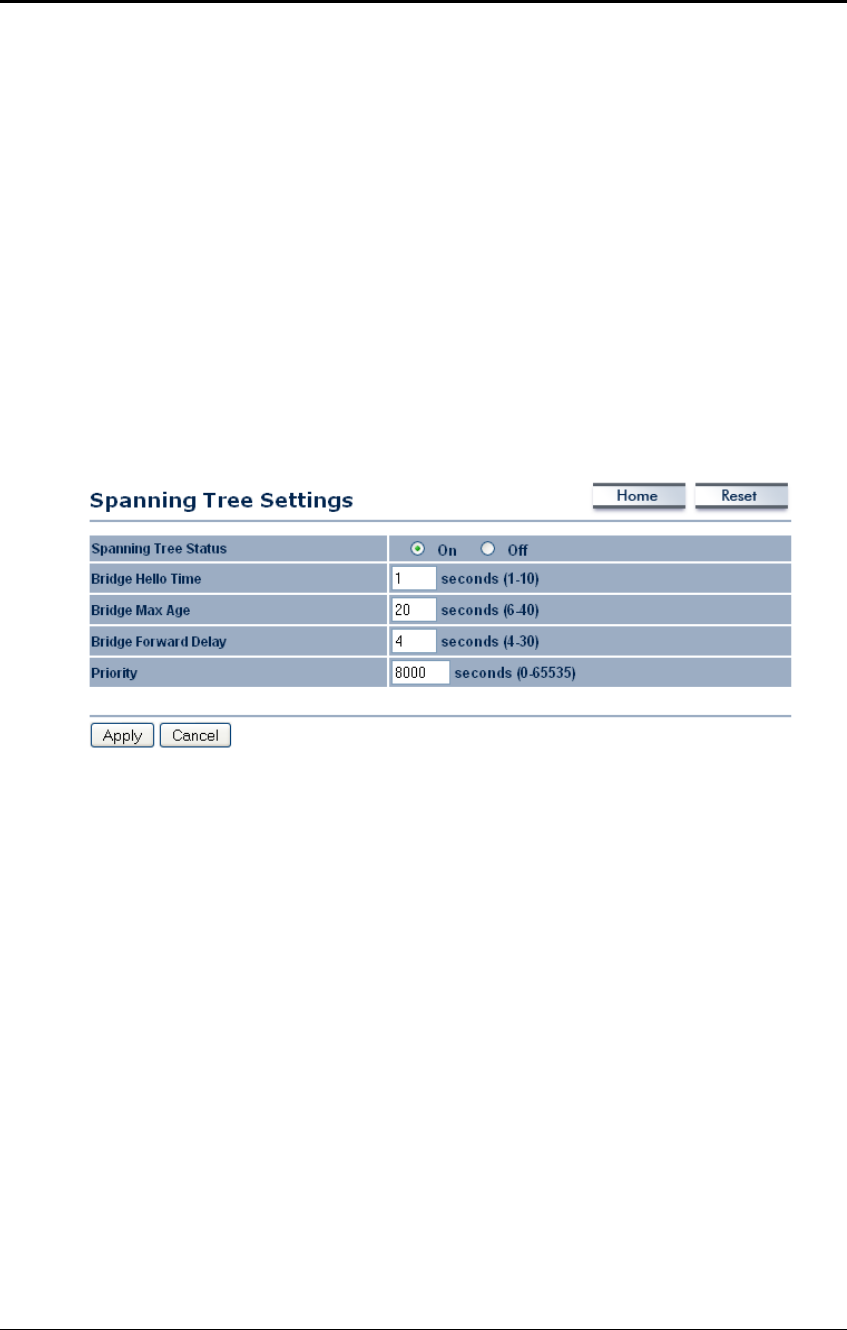
Long Range Wireless Access Point / Client Bridge Version 1.0
16
IP Network Setting: Select Obtain an IP address automatically (DHCP) radio
button if the Access Point is connected to a DHCP server. This will allow the Access
Point to pass IP addresses to the clients associated with it. You may select Specify
an IP Address radio button if you would like the device to use a static IP address. In
this case, you would be required to specify an IP address, subnet mask, and default
gateway IP address.
IP Address: Specify an IP address
IP Subnet Mask: Specify the subnet mask for the IP address
Default Gateway: Specify the IP address of the default gateway.
Click on the Apply button to save the changes.
Spanning Tree Settings
Click on the Spanning Tree link under the System drop-down menu Spanning-Tree
Protocol is a link management protocol that provides path redundancy while
preventing undesirable loops in the network.
Spanning Tree Status: Choose to enable or disable the spanning tree feature.
Bridge Hello Time: Specify the number of seconds for the hello time.
Bridge Max Age: Specify the number of seconds for the max age.
Bridge Forward Delay: Specify the number of seconds for the bridge forward delay.
Priority: Specify the number of seconds for the priority.
Click on the Apply button to save the changes.
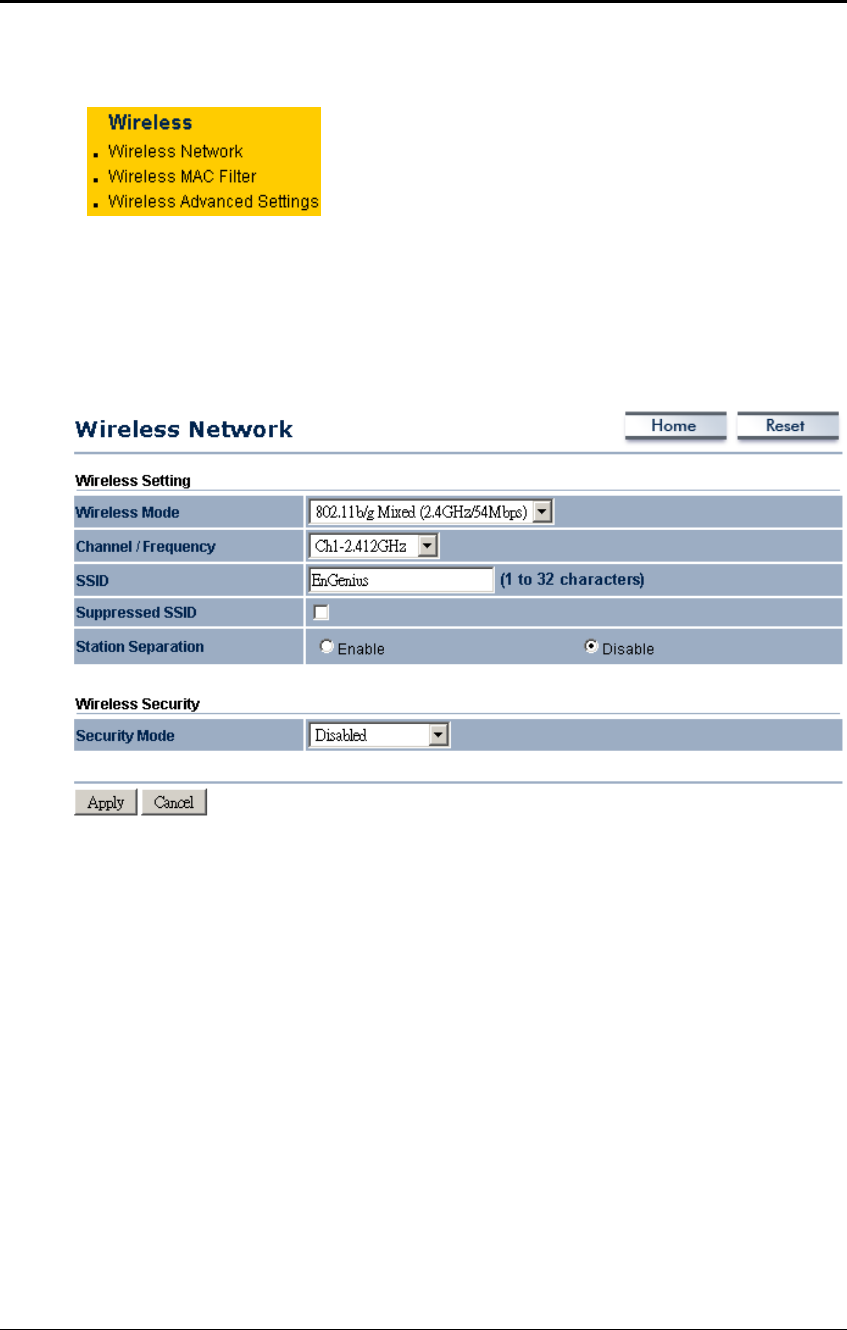
Long Range Wireless Access Point / Client Bridge Version 1.0
17
Wireless
Click on the Wireless link on the navigation
drop-down menu. You will then see four
options: wireless network, wireless MAC filter,
WDS link settings, and wireless advanced
settings. Each option is described below.
Wireless Network
The Wireless Network page allows you to configure the wireless mode, channel,
SSID, and security settings.
Wireless Mode: Depending on the type of wireless clients that are connected to the
network, you may select B, G or B/G-mixed. If you are not sure about which clients
will be accessing the wireless networks, it is recommended that you select B/G-
mixed for the best performance.
Channel: Select a channel from the drop-down list.
Wireless Security - WEP
Security Mode: Select WEP from the drop-down list if your wireless network uses
WEP encryption. WEP is an acronym for Wired Equivalent Privacy, and is a security
protocol that provides the same level of security for wireless networks as for a wired
network.
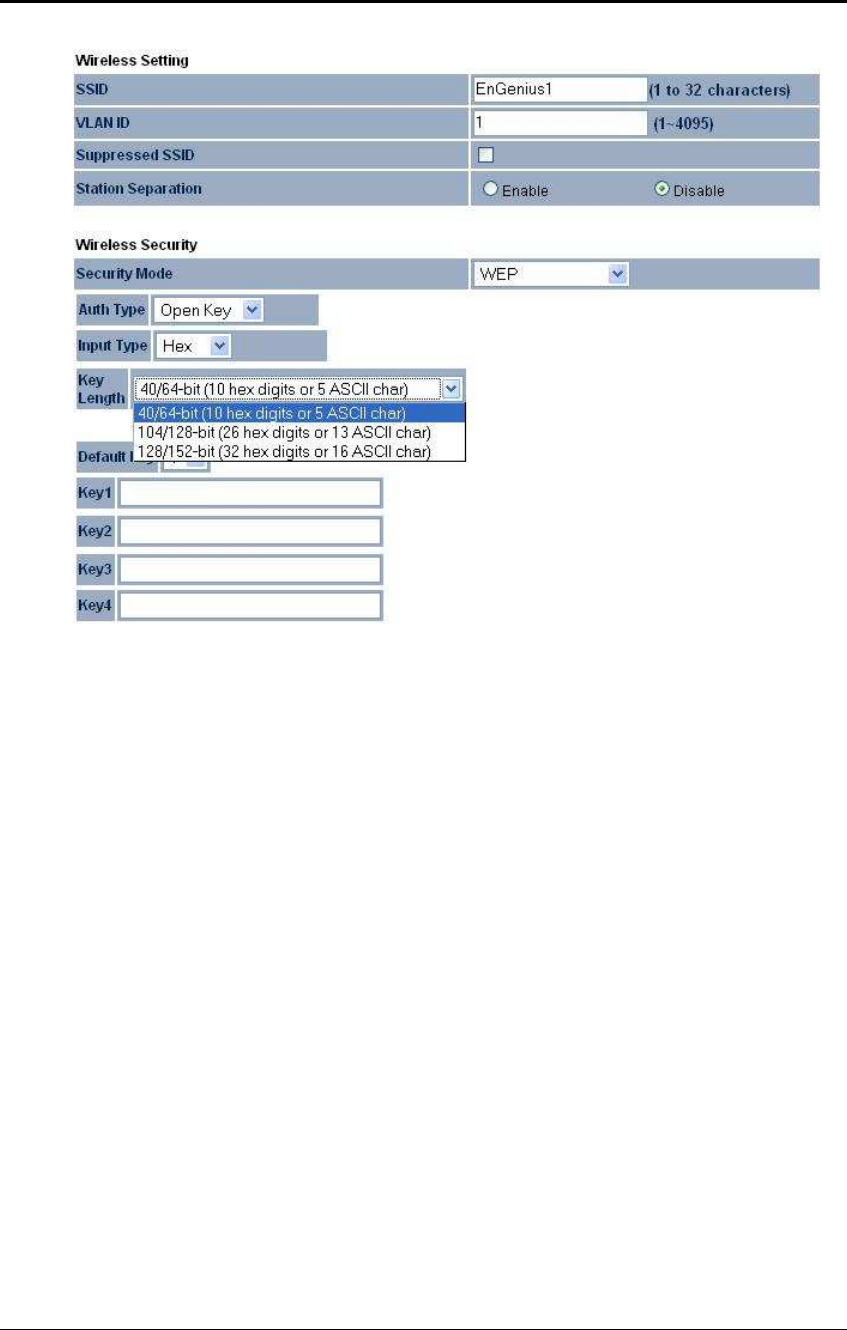
Long Range Wireless Access Point / Client Bridge Version 1.0
18
Authentication Type: Select an authentication method. Options available are Open
Key, Shared Key. An open system allows any client to authenticate as long as it
conforms to any MAC address filter policies that may have been set. All
authentication packets are transmitted without encryption. Shared Key sends an
unencrypted challenge text string to any device attempting to communicate with the
Access Point. The device requesting authentication encrypts the challenge text and
sends it back to the Access Point. If the challenge text is encrypted correctly, the
Access Point allows the requesting device to authenticate. It is recommended to
select Auto if you are not sure which authentication type is used.
Input Type: Select Hex or ASCII from the drop-down list
Key Length: Select a key format from the drop-down list. 64bit-hex keys require 10
characters, where as 128-bit keys require 26 characters. A hex key is defined as a
number between 0 through 9 and letter between A through F and a through f.
Default Key: You may use up to four different keys for four different networks. Select
the current key that will be used.
Key 1-4: You may enter four different WEP keys.
Click on the Apply button to save the changes.
Wireless Security – WPA-PSK, WPA2-PSK, WPA-Mixed
Security Mode: Select WPA-PSK, WPA2-PSK, or WPA-Mixed from the drop-down
list if your wireless network uses WPA pre-shared key.
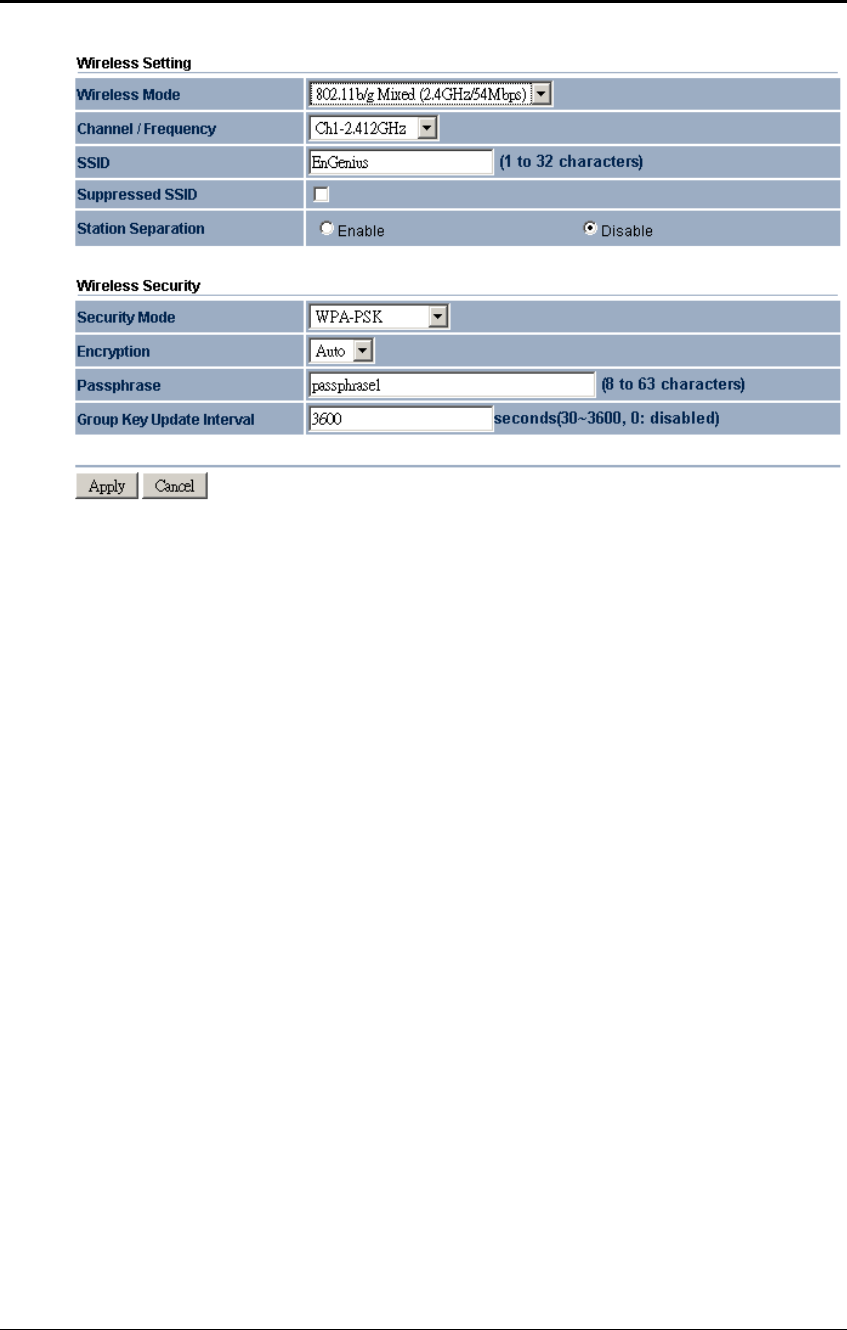
Long Range Wireless Access Point / Client Bridge Version 1.0
19
Encryption: Select TKIP or AES from the drop-down list if your wireless network
uses this encryption. WPA (Wi-Fi Protected Access) was designed to improve upon
the security features of WEP (Wired Equivalent Privacy). The technology is designed
to work with existing Wi-Fi products that have been enabled with WEP. WPA
provides improved data encryption through the Temporal Integrity Protocol (TKIP),
which scrambles the keys using a hashing algorithm and by adding an integrity
checking feature which makes sure that keys haven’t been tampered with.
Passphrase: Specify a passphrase that is shared amongst the Access Points and
clients.
Group Key Update Interval: Specify the number of seconds after which the Access
Point will probe the client for the passphrase.
Click on the Apply button to save the changes.
Wireless Security – WPA, WPA2
Security Mode: Select WPA or WPA2 from the drop-down list if your wireless
network uses WPA. WPA (Wi-Fi Protected Access) was designed to improve upon
the security features of WEP (Wired Equivalent Privacy). The technology is designed
to work with existing Wi-Fi products that have been enabled with WEP. WPA
provides improved data encryption through the Temporal Integrity Protocol (TKIP),
which scrambles the keys using a hashing algorithm and by adding an integrity
checking feature which makes sure that keys haven’t been tampered with.
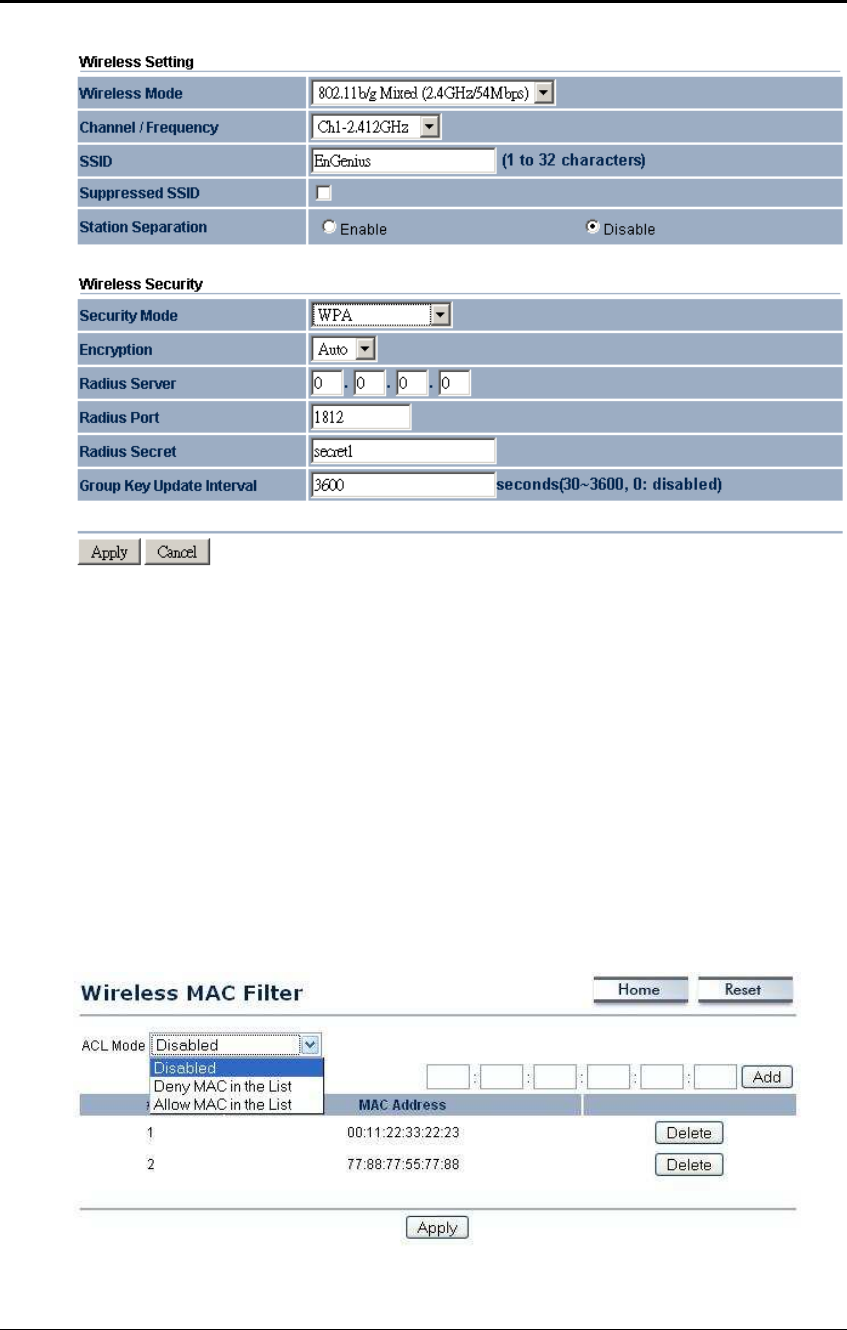
Long Range Wireless Access Point / Client Bridge Version 1.0
20
Encryption: Select TKIP or AES from the drop-down list if your wireless network
uses this encryption.
RADIUS IP Address: Enter the IP address of the RADIUS server.
RADIUS Port: Enter the port number of the RADIUS server. The default is usually
1812.
RADIUS Secret: Enter the shared password of the RADIUS server.
Group Key Update Interval: Specify the number of seconds after which the Access
Point will probe the client for the secret.
Click on the Apply button to save the changes.
Wireless MAC Filter
Click on the Wireless MAC Filter link under the Wireless menu. On this page you
can filter the MAC address by allowing or blocking access the network.
ACL (Access Control) Mode: You may choose to Disable, Allow Listed, or Deny
Listed MAC addresses from associating with the network. By selecting Allow MAC
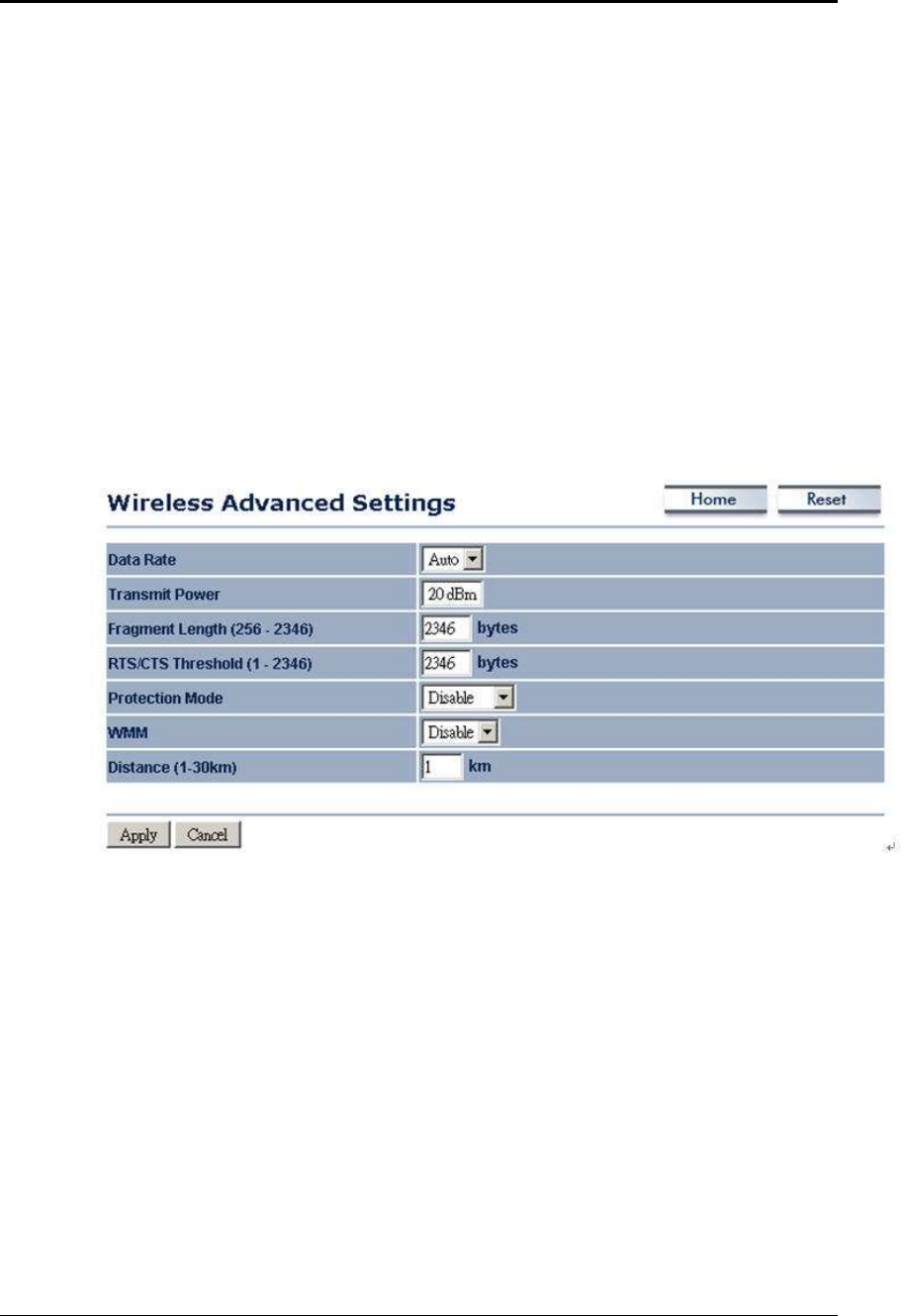
Long Range Wireless Access Point / Client Bridge Version 1.0
21
in the List, only the address listed in the table will have access to the network; all
other clients will be blocked. On the other hand, selected Deny MAC in the List,
only the listed MAC addresses will be blocked from accessing the network; all other
clients will have access to the network.
MAC Address: Enter the MAC address.
This table lists the blocked or allowed MAC addresses; you may delete selected
MAC address or delete all the addresses from the table by clicking on the Delete
button.
Click on the Apply button to save the changes.
Wireless Advanced Settings
Click on the Wireless Advanced Settings link. On this page you can configure the
advanced settings to tweak the performance of your wireless network. Options
available are: data rate, transmit power, fragmentation threshold, RTS threshold,
protection mode and distance.
Data Rate: If you would like to force a data rate, you may select one from the drop-
down list. However, for best performance it is recommended to use the Auto setting.
Transmit Power : Regular Power
Fragment: Packets over the specified size will be fragmented in order to improve
performance on noisy networks.
RTS Threshold: Packets over the specified size will use the RTS/CTS mechanism to
maintain performance in noisy networks and preventing hidden nodes from
degrading the performance.
Protection Mode: If your wireless network is using both 802.11b and 802.g devices
then it is recommended to enable this feature so that the 802.11b devices will not
degrade the performance of 802.11g devices.
WMM: Enable wireless Quality of Service
Distance (1-30km): Specify a distance between 1 and 30Km.
Click on the Apply button to save the changes.
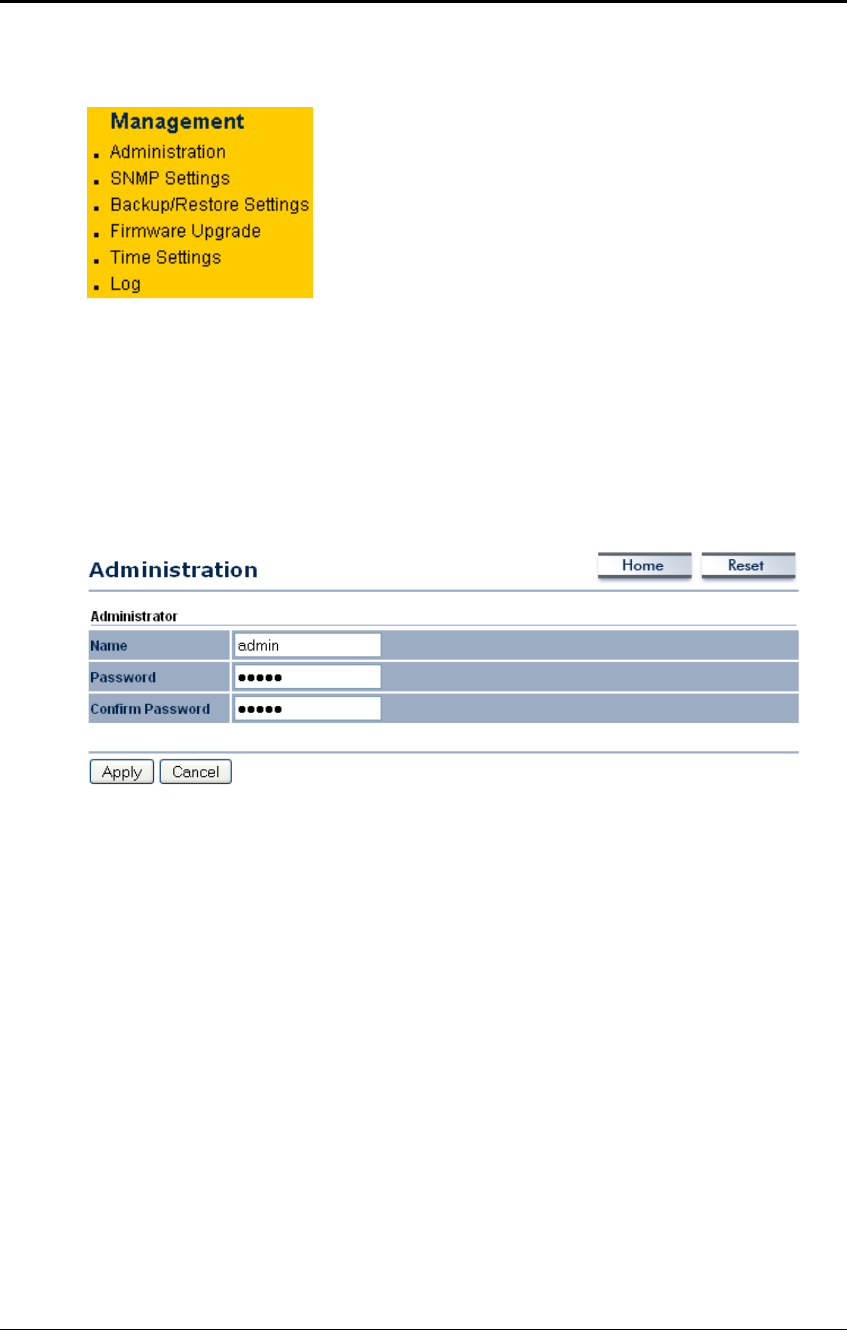
Long Range Wireless Access Point / Client Bridge Version 1.0
22
Management
Click on the Management link on the
navigation drop-down menu. You will then see
seven options: administration, SNMP settings,
backup/restore settings, firmware upgrade,
time settings, and log. Each option is described
below.
Administration
Click on the Administration link under the Management menu. This option allows
you to create a user name and password for the device. By default, this device is
configured without a user name and password admin. For security reasons it is
highly recommended that you create a new user name and password.
Name: Specify a user name into the first field.
Password: Specify a password into this field and then re-type the password into the
Confirm Password field.
Click on the Apply button to save the changes.
SNMP Settings
Click on the SNMP Settings link under the Management menu. This option allows
you to assign the contact details, location, and community name and trap settings for
SNMP. This is a networking management protocol used to monitor network-attached
devices. SNMP allows messages (called protocol data units) to be sent to various
parts of a network. Upon receiving these messages, SNMP-compatible devices
(called agents) return data stored in their Management Information Bases. .
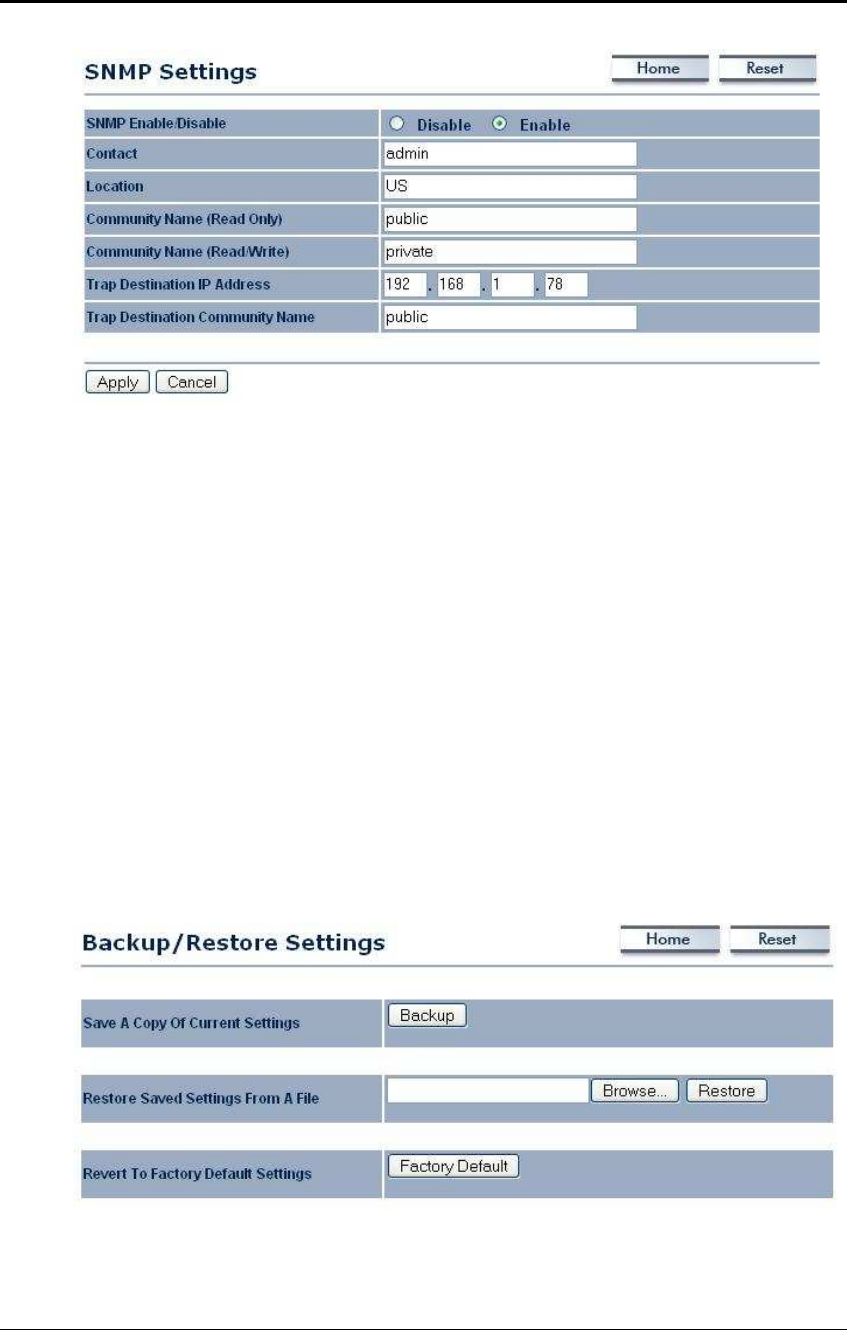
Long Range Wireless Access Point / Client Bridge Version 1.0
23
SNMP Enable/Disable: Choose to enable or disable the SNMP feature.
Contact: Specify the contact details of the device.
Location: Specify the location of the device.
Read-Only Community Name: Specify the password for access the SNMP
community for read only access.
Read-Write Community Name: Specify the password for access to the SNMP
community with read/write access.
Send SNMP Trap: Specify the IP address of the computer that will receive the
SNMP traps.
Trap Community Name: Specify the password for the SNMP trap community.
Click on the Apply button to save the changes.
Backup/Restore settings, Reset to factory default settings
Click on the Backup/Restore Setting link under the Management menu. This option
is used to save the current settings of the device in a file on your local disk or load
settings on to the device from a local disk. This feature is very handy for
administrators who have several devices that need to be configured with the same
settings.
Save a copy of the current settings: Click on the Backup button to save the current
configuration.
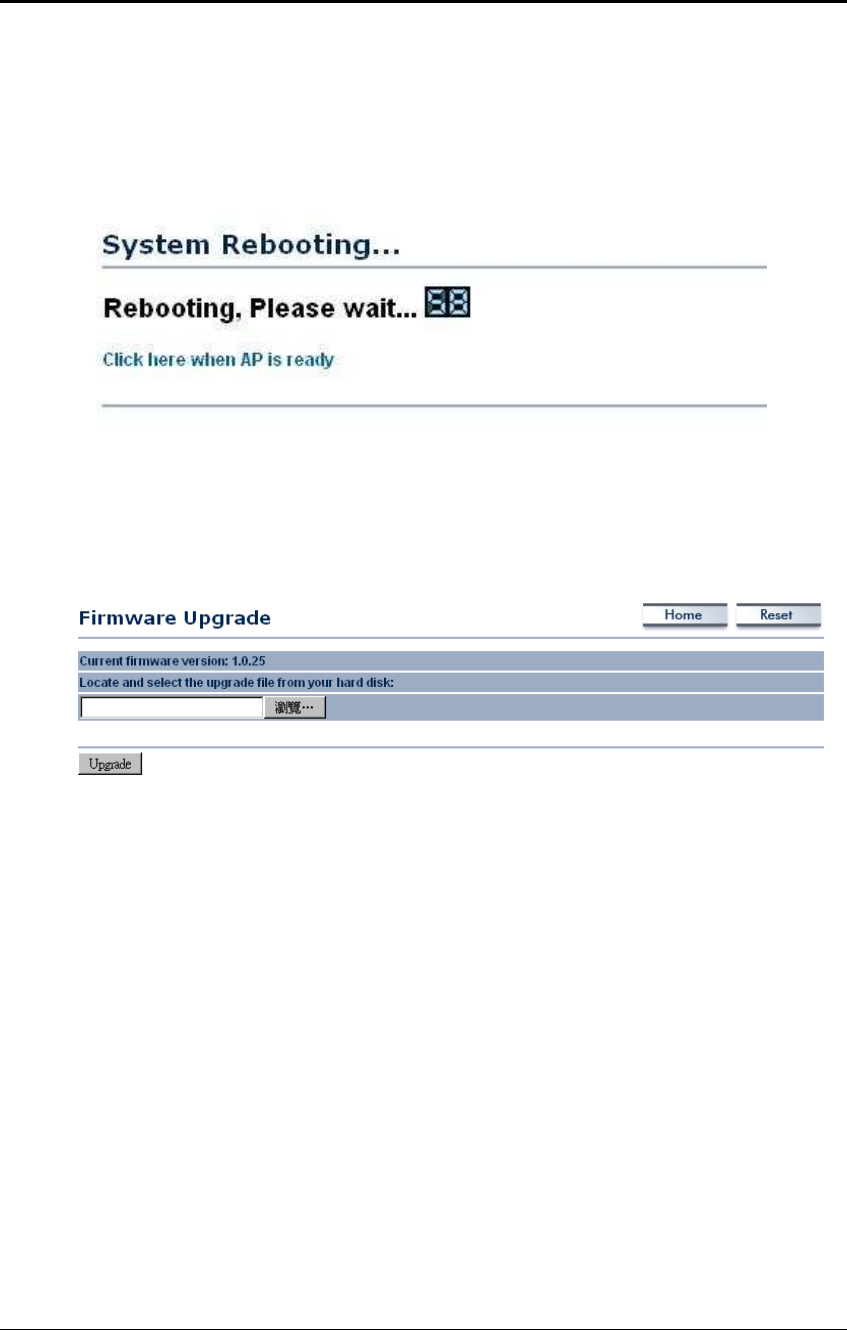
Long Range Wireless Access Point / Client Bridge Version 1.0
24
Restore saved settings from a file: Once a file has been backed up, you may
restore it by clicking on the Browse button to select the file, and then the Restore
button.
Revert to factory default settings: Click on the Factory Default Settings button to
reset the device to the default settings. Please wait while the device restart and then
access the device using the default IP address: 192.168.1.1
Firmware Upgrade
Click on the Upgrade Firmware link under the Management menu. This page is
used to upgrade the firmware on the device. Make sure that downloaded the
appropriate firmware from your vendor.
Click on the Browse button and then select the appropriate firmware and then click
on the Upgrade button.
Note: The upgrade process may take about 1 minute to complete. Do not power off
the device during this process as it may crash the device and make it unusable. The
device will restart automatically once the upgrade is complete.
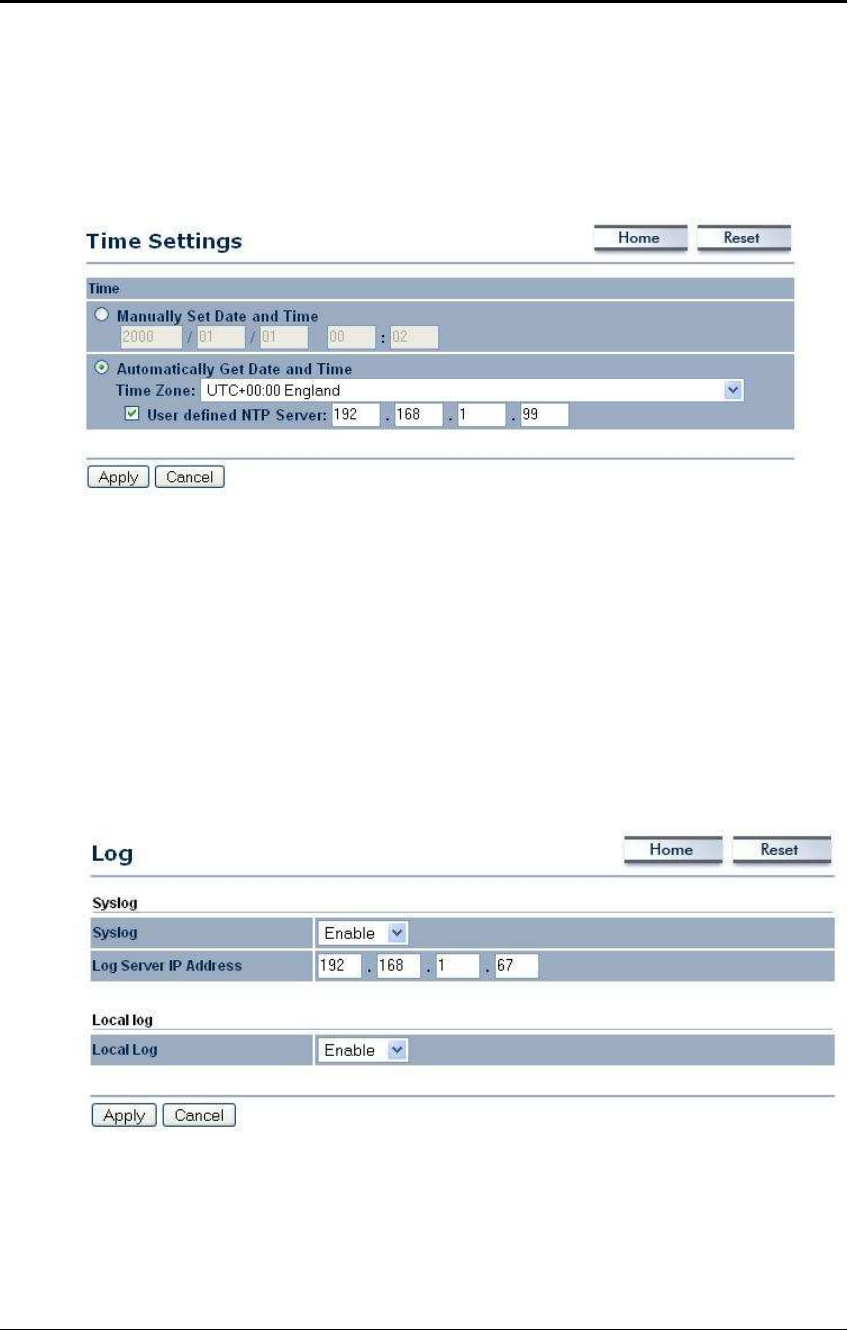
Long Range Wireless Access Point / Client Bridge Version 1.0
25
Time Settings
Click on the Time Settings link under the Management menu. This page allows you
to configure the time on the device. You may do this manually or by connecting to a
NTP server.
Manually Set Date and Time: Specify the date and time
Automatically Get Date and Time: Select the time zone from the drop down list and
then specify the IP address of the NTP server.
Click on the Apply button to save the changes.
Log
Click on the Log link under the Management menu. The Log page displays a list of
events that are triggered on the Ethernet and Wireless interface. This log can be
referred when an unknown error occurs on the system or when a report needs to be
sent to the technical support department for debugging purposes.
Syslog: Choose to enable or disable the system log.
Log Server IP Address: Specify the IP address of the server that will receive the
system log.
Local Log: Choose to enable or disable the local log.
Click on the Apply button to save the changes.
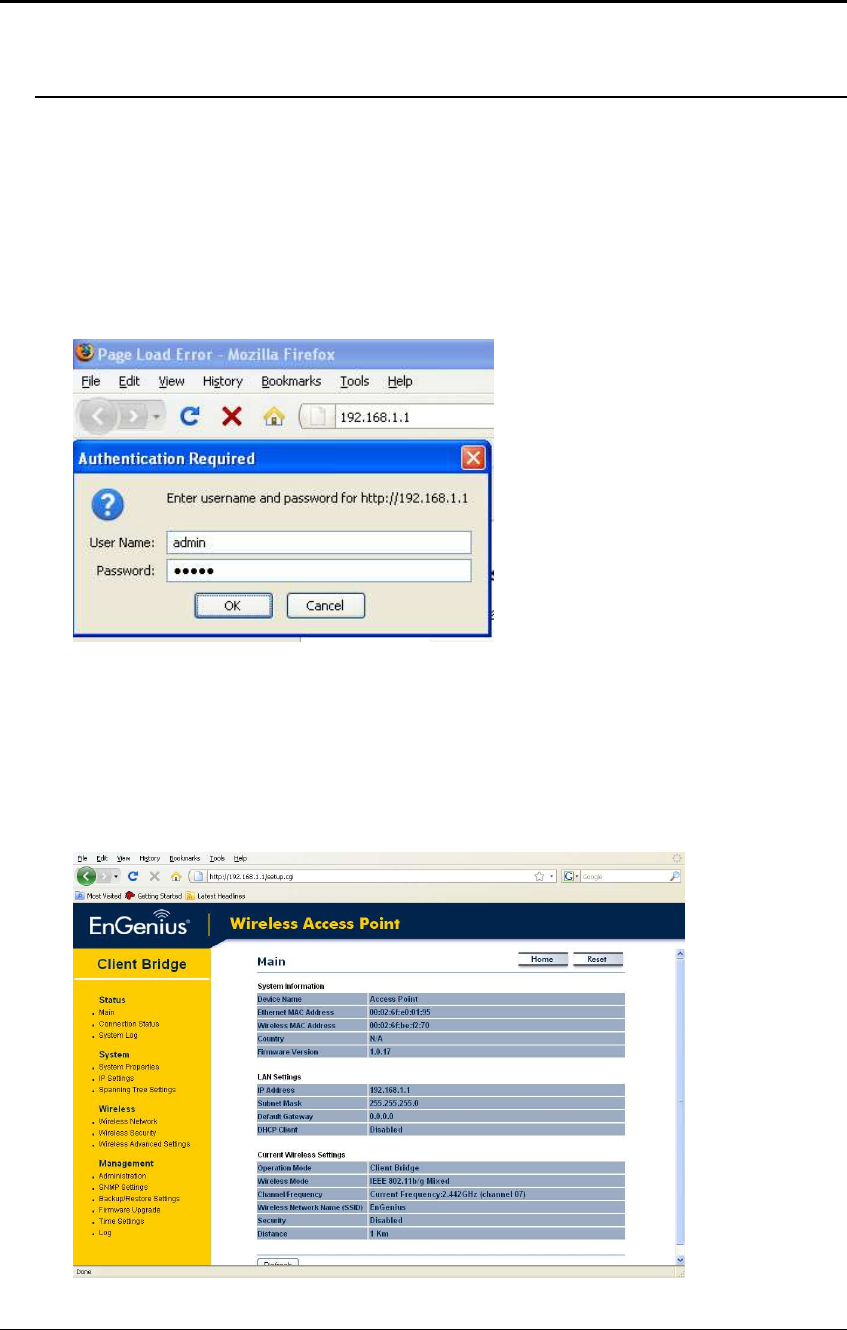
Long Range Wireless Access Point / Client Bridge Version 1.0
26
5 Client Bridge Operating Mode
5.1 Logging In
To configure the device through the web-browser, enter the IP address of the device
(default: 192.168.1.1) into the address bar of the web-browser and press Enter.
Make sure that the device and your computers are configured on the same subnet.
Refer to Chapter 2 in order to configure the IP address of your computer.
After connecting to the IP address, the web-browser will display the login page.
Specify admin for both the user name and password.
After logging in you will graphical user interface (GUI) of the device. The navigation
drop-down menu on left is divided into four sections:
1. Status: Displays the overall status, connection status, and event log.
2. System: This menu includes the system properties, IP and Spanning Tree settings.
3. Wireless: This menu includes status, basic, advanced, and security.
4. Management: This menu includes the admin setup, SNMP, firmware upgrade, and
save/restore backup.
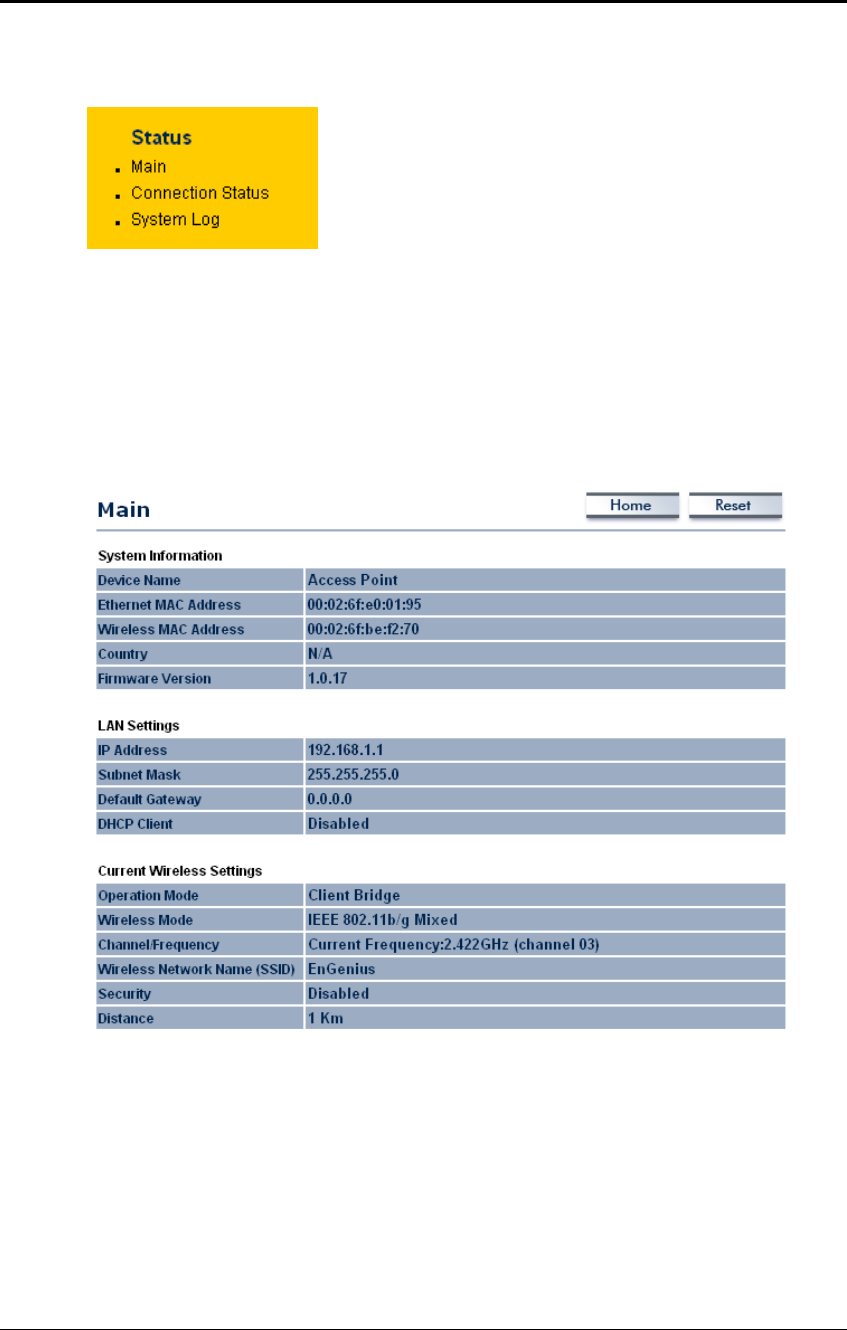
Long Range Wireless Access Point / Client Bridge Version 1.0
27
5.2 Status
Click on the Status link on the navigation
drop-down menu. You will then see three
options: Main, Connection Status, and System
Log. Each option is described in detail below.
5.2.1 Main
Click on the Main link under the Status drop-down menu. The status that is
displayed corresponds with the operating mode that is selected. Information such as
system up time, firmware version, serial number, kernel version and application
version are displayed in the ‘System’ section. LAN IP address, subnet mask, and
MAC address are displayed in the ‘System’ section. In the ‘Wireless section, the
frequency, channel is displayed.
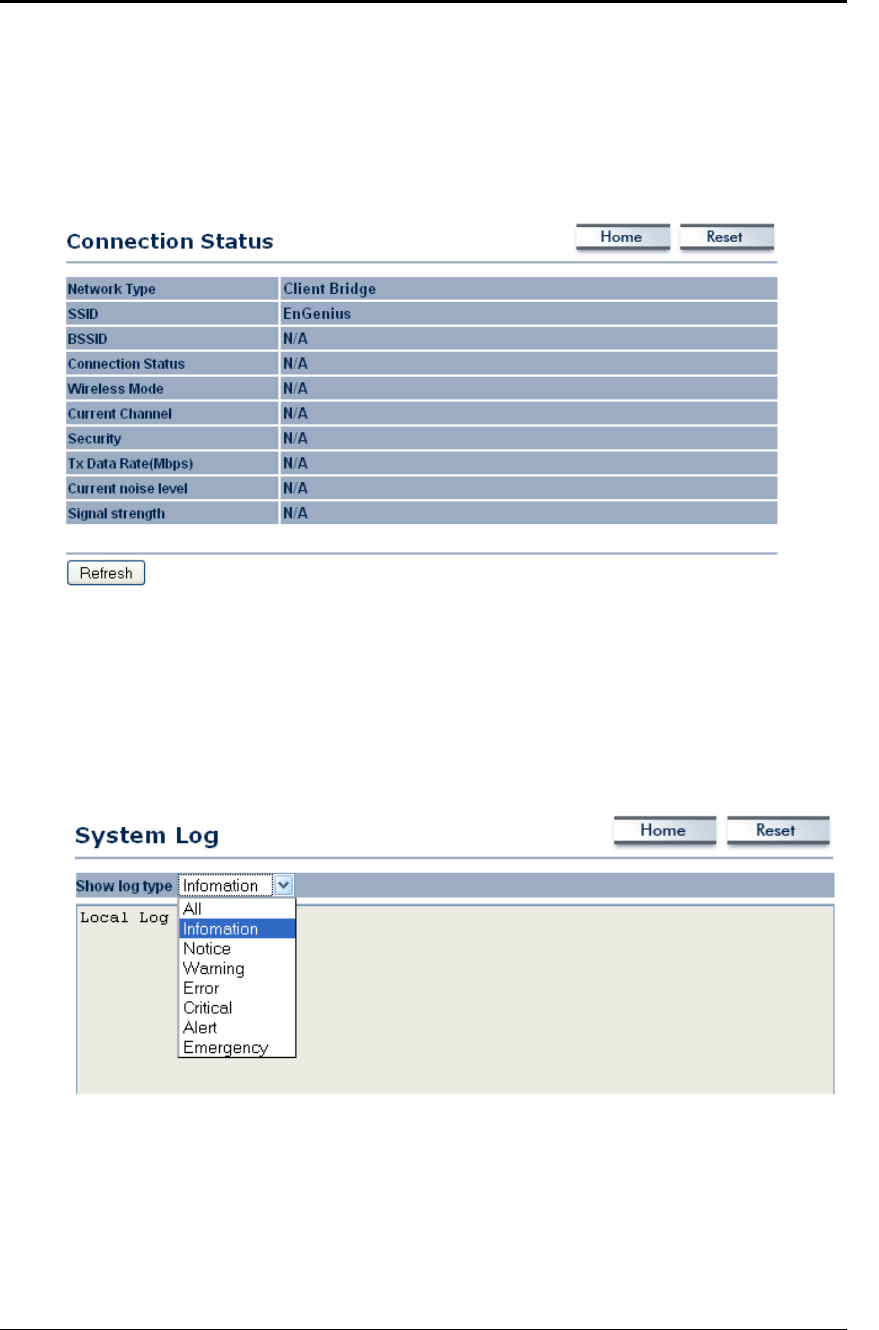
Long Range Wireless Access Point / Client Bridge Version 1.0
28
5.2.2 Connection Status
Click on the Connection Status link under the Status drop-down menu. This page
displays the current status of the network, including network type, SSID, BSSID,
connection status, wireless mode, current channel, security, data rate, noise level
and signal strength.
5.2.3 System Log
Click on the System Log link under the Status drop-down menu. The device
automatically logs (records) events of possible interest in its internal memory. If there
is not enough internal memory for all events, logs of older events are deleted, but
logs of the latest events are retained.
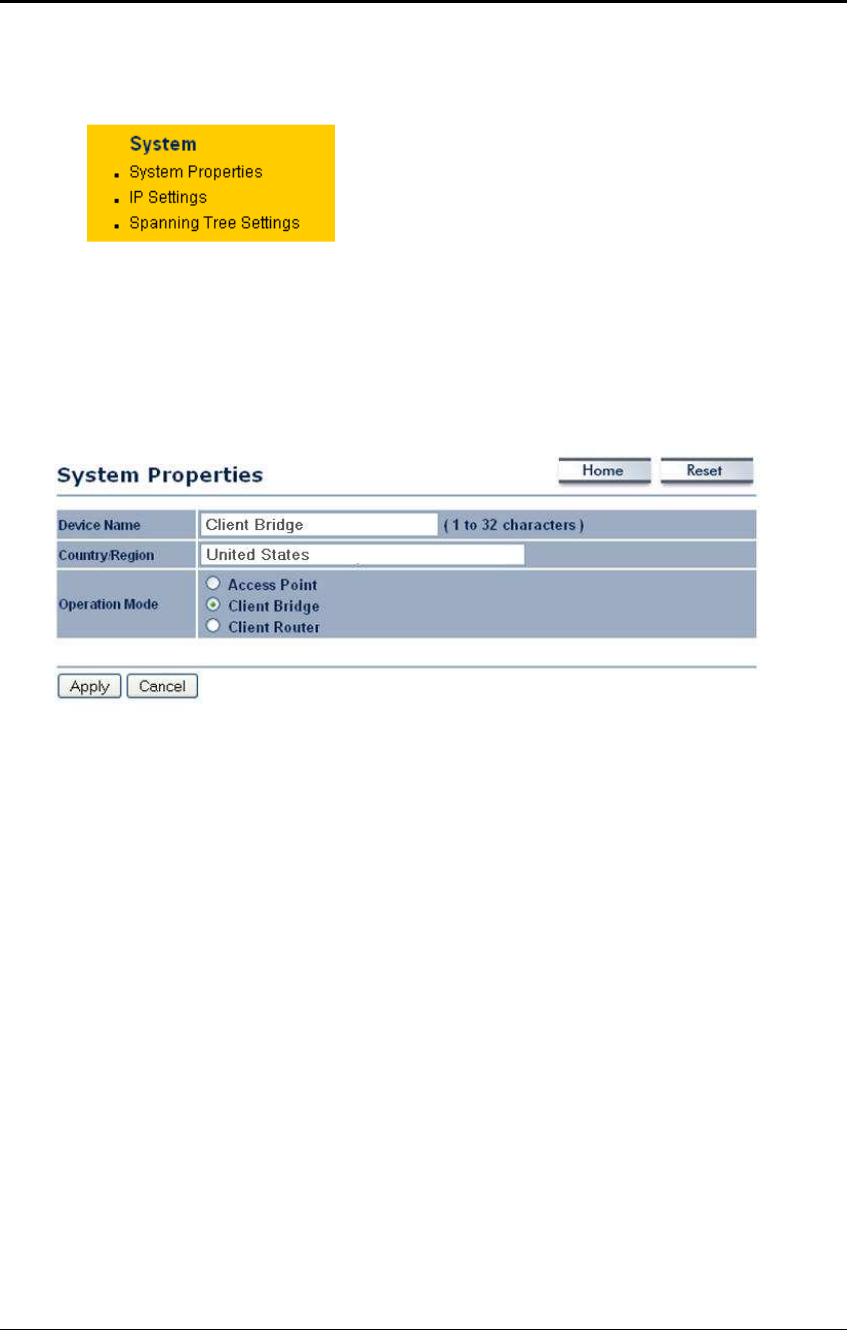
Long Range Wireless Access Point / Client Bridge Version 1.0
29
5.3 System
Click on the System link on the navigation
drop-down menu. You will then see three
options: System Properties, IP Settings, and
Spanning Tree Settings. Each option is
described in detail below.
5.3.1 System Properties
Click on the System Properties link under the System drop-down menu. This page
allows you to switch the operating mode of the device, as well as specify a name and
select the operating region.
Device Name: Specify a name for the device (this is not the SSID),
Country/Region: United States.
Operating Mode: Select and operating mode. Configuration for each operating
mode is described in their respective chapters.
Click on the Apply button to save the changes.
5.3.2 IP Settings
Click on the IP Settings link under the System drop-down menu This page allows
you to configure the device with a static IP address or a DHCP client.
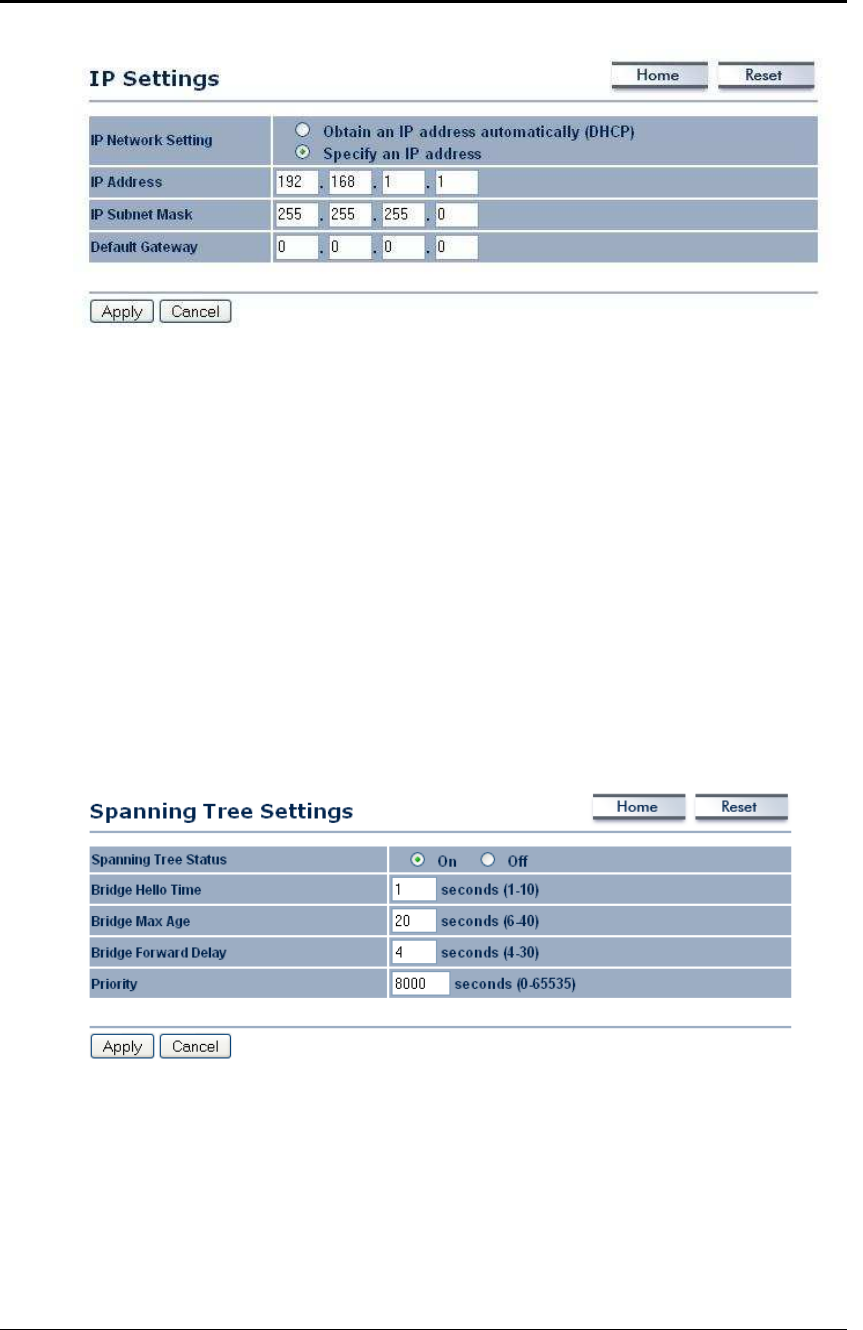
Long Range Wireless Access Point / Client Bridge Version 1.0
30
IP Network Setting: Select Obtain an IP address automatically (DHCP) radio
button if the Access Point is connected to a DHCP server. This will allow the Access
Point to pass IP addresses to the clients associated with it. You may select Specify
an IP Address radio button if you would like the device to use a static IP address. In
this case, you would be required to specify an IP address, subnet mask, and default
gateway IP address.
IP Address: Specify an IP address
IP Subnet Mask: Specify the subnet mask for the IP address
Default Gateway: Specify the IP address of the default gateway.
Click on the Apply button to save the changes.
5.3.3 Spanning Tree Settings
Click on the Spanning Tree link under the System drop-down menu Spanning-Tree
Protocol is a link management protocol that provides path redundancy while
preventing undesirable loops in the network.
Spanning Tree Status: Choose to enable or disable the spanning tree feature.
Bridge Hello Time: Specify the number of seconds for the hello time.
Bridge Max Age: Specify the number of seconds for the max age.
Bridge Forward Delay: Specify the number of seconds for the bridge forward delay.
Priority: Specify the number of seconds for the priority.
Click on the Apply button to save the changes.
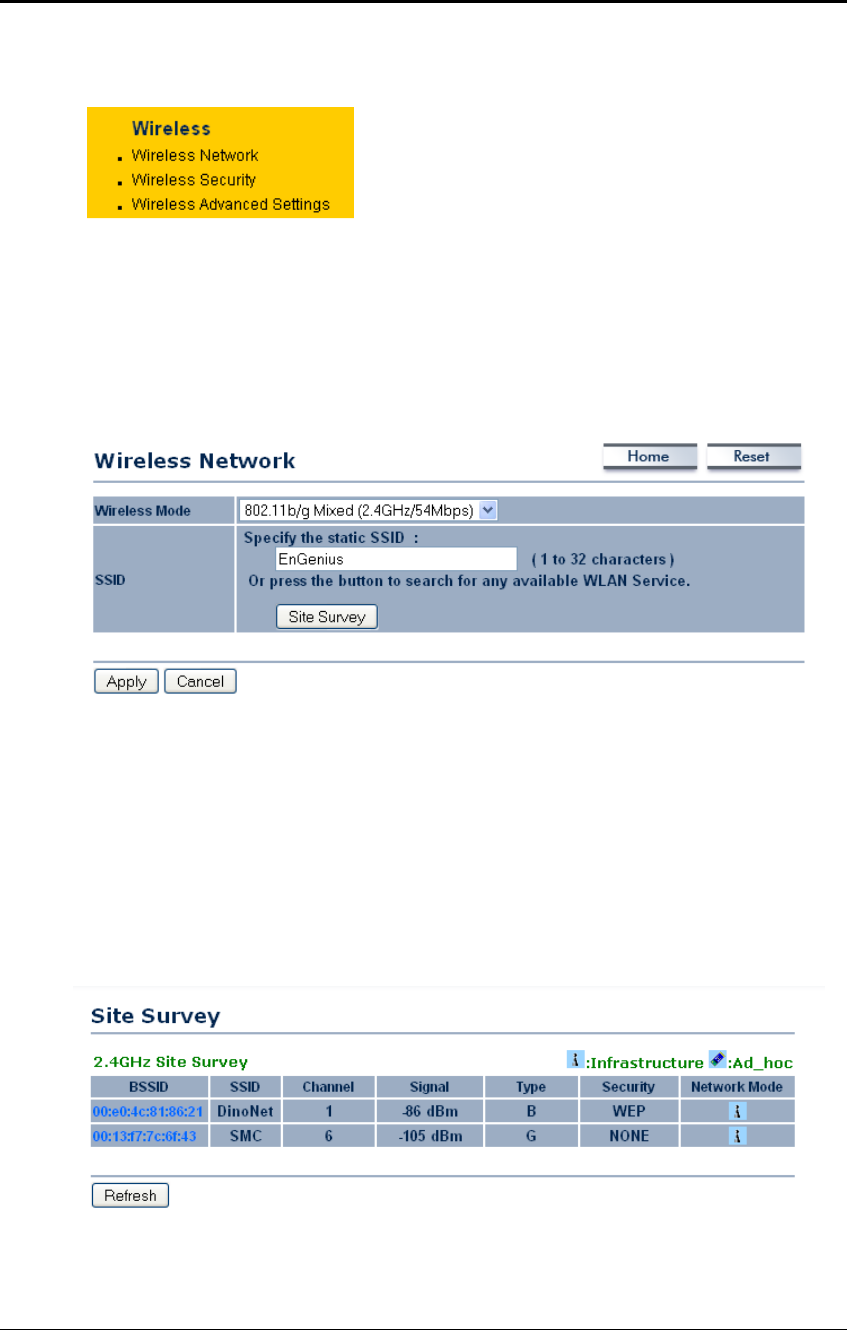
Long Range Wireless Access Point / Client Bridge Version 1.0
31
5.4
Wireless
Click on the Wireless link on the
navigation drop-down menu. You will
then see three options: wireless network,
wireless security, and wireless
advanced settings. Each option is
described below.
5.4.1 Wireless Network
The Wireless Network page allows you to configure the wireless mode, channel,
SSID, and security settings.
Wireless Mode: Depending on the type of wireless clients that are connected to the
network, you may select B, G, or B/G-mixed. If you are not sure about which clients
will be accessing the wireless networks, it is recommended that you select B/G-
mixed for the best performance.
SSID: The SSID is a unique named shared amongst all the points of the wireless
network. The SSID must be identical on all points of the wireless network and cannot
exceed 32 characters. You may specify an SSID or select one from the Site Survey.
Site Survey: Click on the Site Survey button in order to scan the 2.4GHz frequency
for devices that broadcast their SSID. Click on the BSSID link to connect to the
Access Point. Click on the Refresh button to re-scan the frequency.
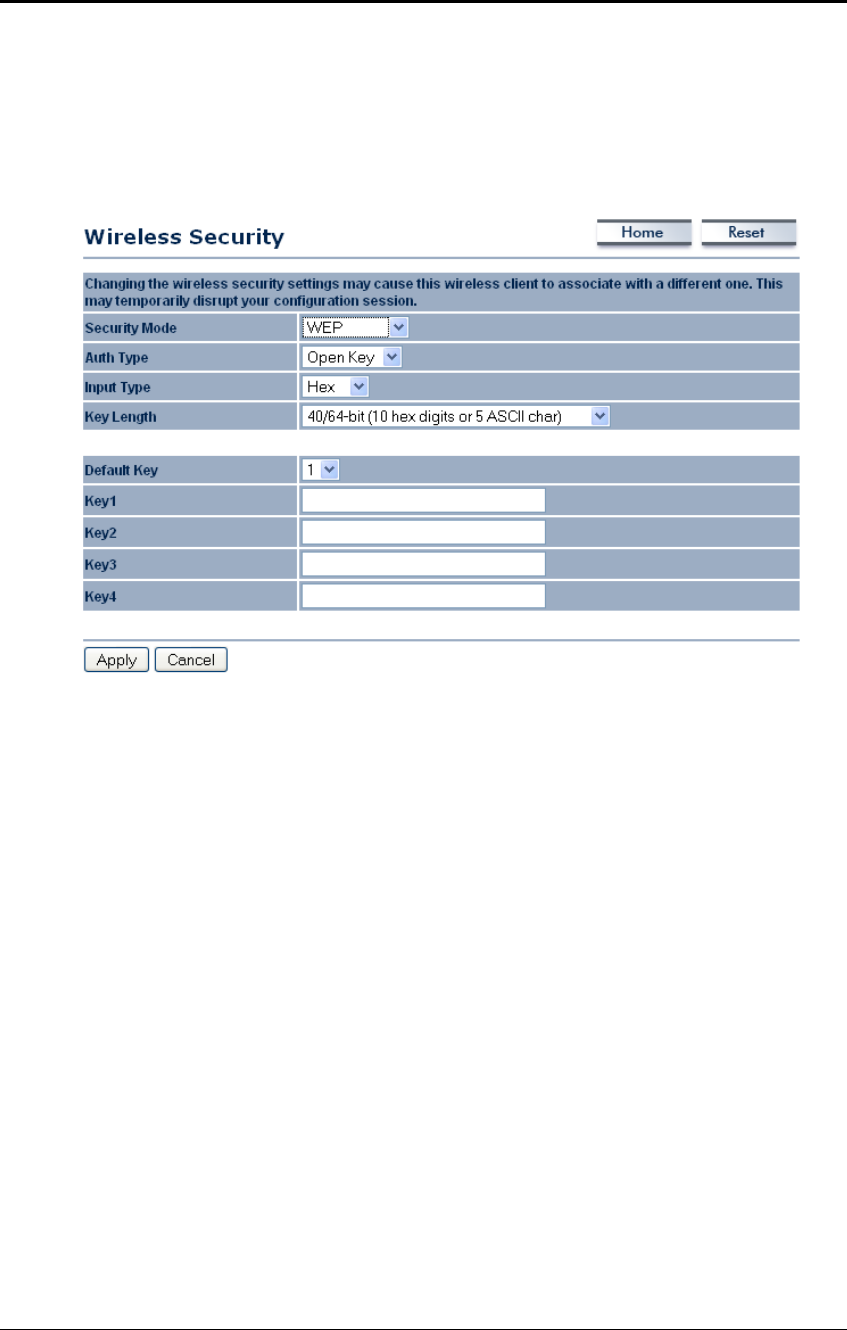
Long Range Wireless Access Point / Client Bridge Version 1.0
32
5.4.2 Wireless Security - WEP
Security Mode: Select WEP from the drop-down list if your wireless network uses
WEP encryption. WEP is an acronym for Wired Equivalent Privacy, and is a security
protocol that provides the same level of security for wireless networks as for a wired
network.
Authentication Type: Select an authentication method. Options available are Open
Key, Shared Key. An open system allows any client to authenticate as long as it
conforms to any MAC address filter policies that may have been set. All
authentication packets are transmitted without encryption. Shared Key sends an
unencrypted challenge text string to any device attempting to communicate with the
Access Point. The device requesting authentication encrypts the challenge text and
sends it back to the Access Point. If the challenge text is encrypted correctly, the
Access Point allows the requesting device to authenticate. It is recommended to
select Auto if you are not sure which authentication type is used.
Input Type: Select Hex or ASCII from the drop-down list
Key Length: Select a key format from the drop-down list. 64bit-hex keys require 10
characters, where as 128-bit keys require 26 characters. A hex key is defined as a
number between 0 through 9 and letter between A through F and a through f.
Default Key: You may use up to four different keys for four different networks. Select
the current key that will be used.
Key 1-4: You may enter four different WEP keys.
Click on the Apply button to save the changes.
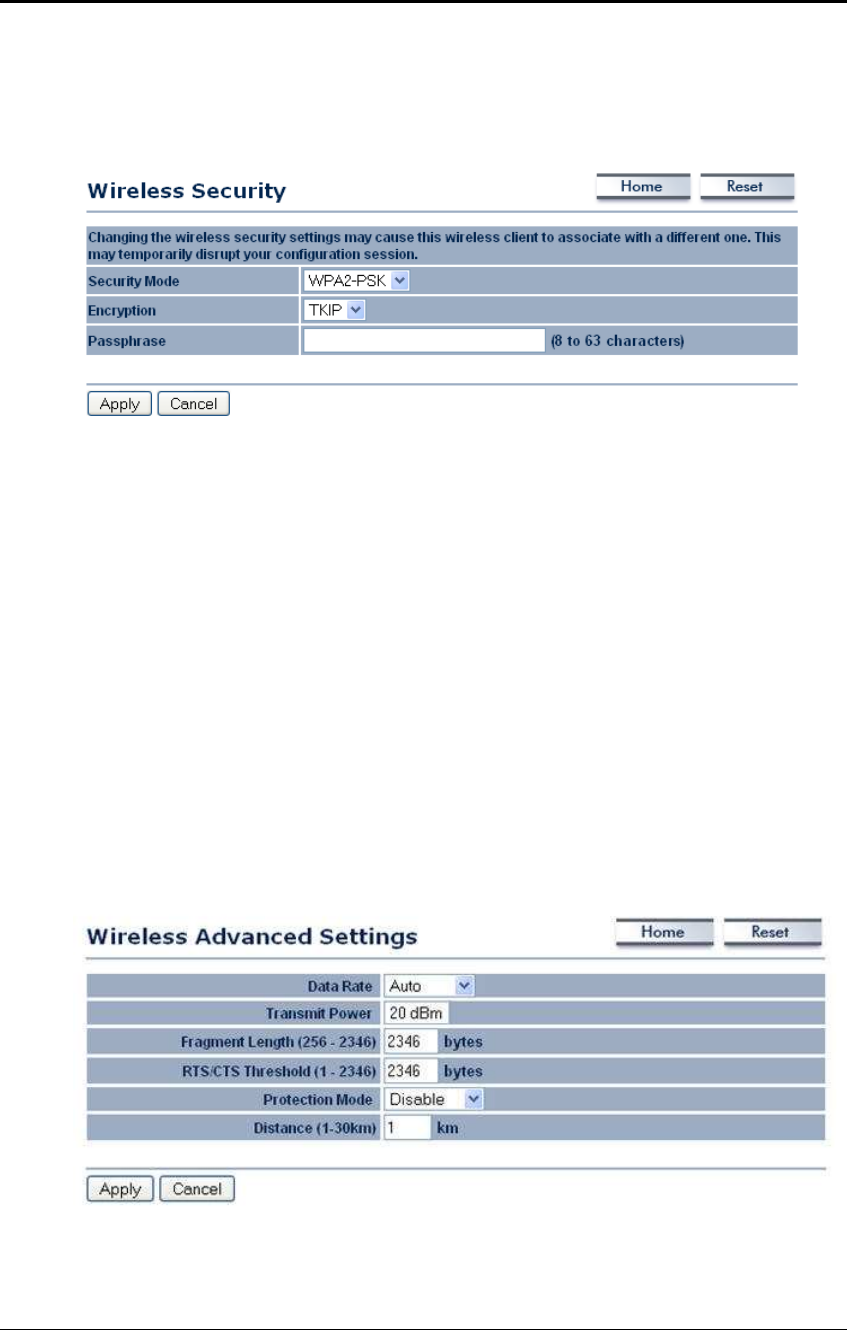
Long Range Wireless Access Point / Client Bridge Version 1.0
33
5.4.3 Wireless Security – WPA-PSK, WPA2-PSK,
Security Mode: Select WPA-PSK, or WPA2-PSK from the drop-down list if your
wireless network uses WPA pre-shared key.
Encryption: Select TKIP or AES from the drop-down list if your wireless network
uses this encryption. WPA (Wi-Fi Protected Access) was designed to improve upon
the security features of WEP (Wired Equivalent Privacy). The technology is designed
to work with existing Wi-Fi products that have been enabled with WEP. WPA
provides improved data encryption through the Temporal Integrity Protocol (TKIP),
which scrambles the keys using a hashing algorithm and by adding an integrity
checking feature which makes sure that keys haven’t been tampered with.
Passphrase: Specify a passphrase that is shared amongst the Access Points and
clients.
Click on the Apply button to save the changes.
5.4.4 Wireless Advanced Settings
Click on the Wireless Advanced Settings link. On this page you can configure the
advanced settings to tweak the performance of your wireless network. Options
available are: data rate, transmit power, fragmentation threshold, RTS threshold,
protection mode and distance.
Data Rate: If you would like to force a data rate, you may select one from the drop-
down list. However, for best performance it is recommended to use the Auto setting.
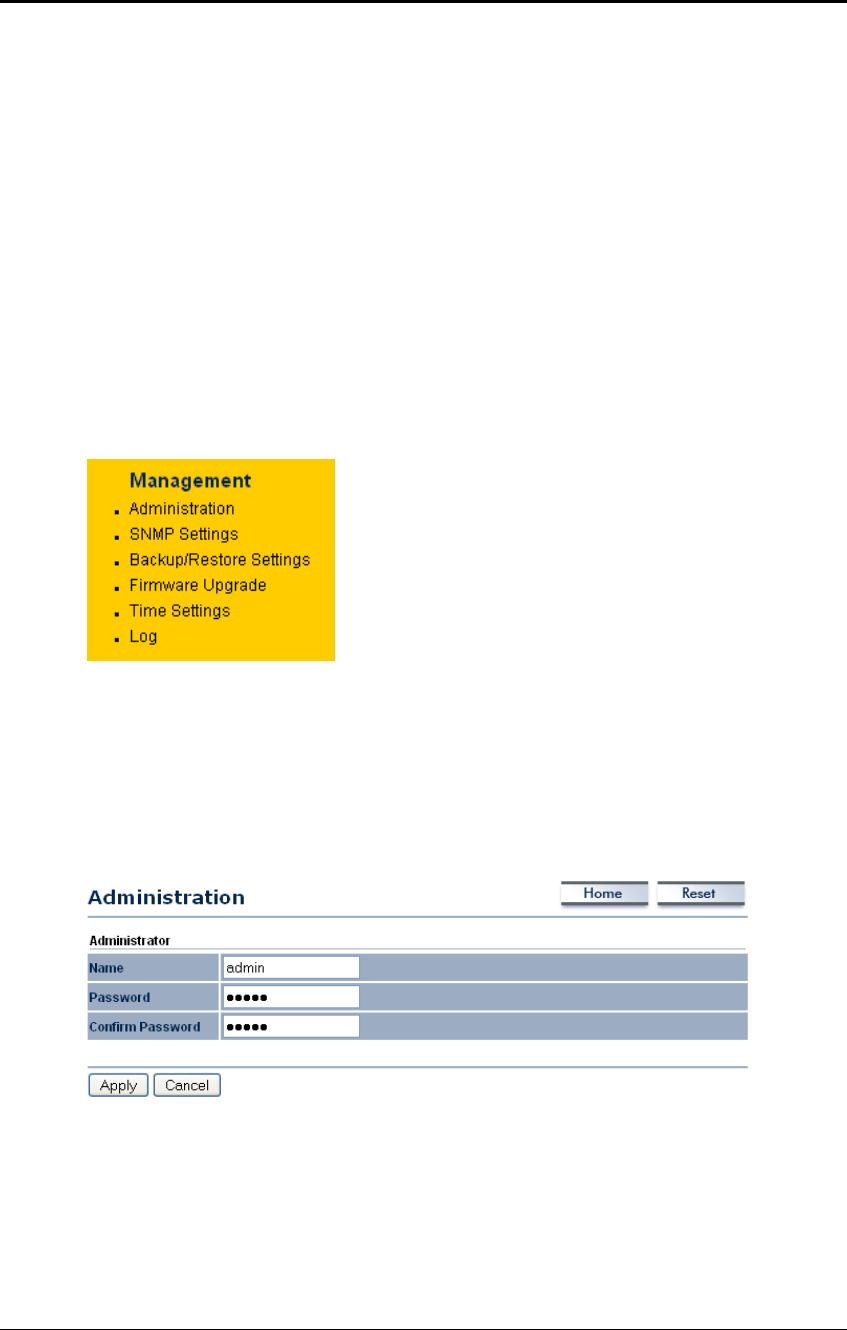
Long Range Wireless Access Point / Client Bridge Version 1.0
34
Transmit Power: Regular Power
Fragment: Packets over the specified size will be fragmented in order to improve
performance on noisy networks.
RTS Threshold: Packets over the specified size will use the RTS/CTS mechanism to
maintain performance in noisy networks and preventing hidden nodes from
degrading the performance.
Protection Mode: If your wireless network is using both 802.11b and 802.g devices
then it is recommended to enable this feature so that the 802.11b devices will not
degrade the performance of 802.11g devices.
Distance (1-30km): Specify a distance between 1 and 30Km.
Click on the Apply button to save the changes.
5.5
Management
Click on the Management link on the
navigation drop-down menu. You will then
see six options: administration, SNMP
settings, backup/restore settings, firmware
upgrade, time settings, and log. Each option
is described below.
5.5.1 Administration
Click on the Administration link under the Management menu. This option allows
you to create a user name and password for the device. By default, this device is
configured without a user name and password admin. For security reasons it is
highly recommended that you create a new user name and password.
Name: Specify a user name into the first field.
Password: Specify a password into this field and then re-type the password into the
Confirm Password field.
Click on the Apply button to save the changes.
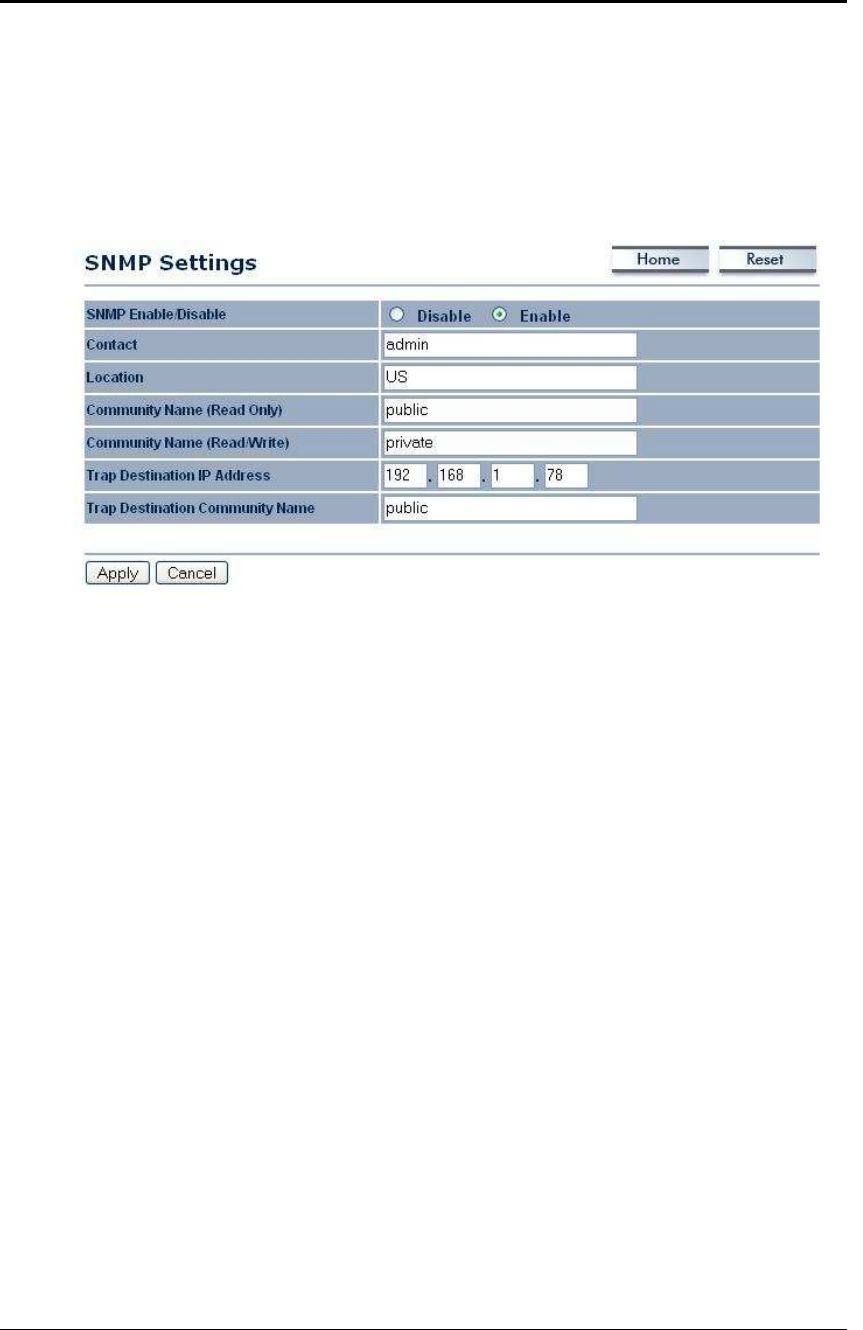
Long Range Wireless Access Point / Client Bridge Version 1.0
35
5.5.2 SNMP Settings
Click on the SNMP Settings link under the Management menu. This option allows
you to assign the contact details, location, and community name and trap settings for
SNMP. This is a networking management protocol used to monitor network-attached
devices. SNMP allows messages (called protocol data units) to be sent to various
parts of a network. Upon receiving these messages, SNMP-compatible devices
(called agents) return data stored in their Management Information Bases. .
SNMP Enable/Disable: Choose to enable or disable the SNMP feature.
Contact: Specify the contact details of the device.
Location: Specify the location of the device.
Read-Only Community Name: Specify the password for access the SNMP
community for read only access.
Read-Write Community Name: Specify the password for access to the SNMP
community with read/write access.
Send SNMP Trap: Specify the IP address of the computer that will receive the
SNMP traps.
Trap Community Name: Specify the password for the SNMP trap community.
Click on the Apply button to save the changes.
5.5.3 Backup/Restore settings, Reset to factory default settings
Click on the Backup/Restore Setting link under the Management menu. This option
is used to save the current settings of the device in a file on your local disk or load
settings on to the device from a local disk. This feature is very handy for
administrators who have several devices that need to be configured with the same
settings.
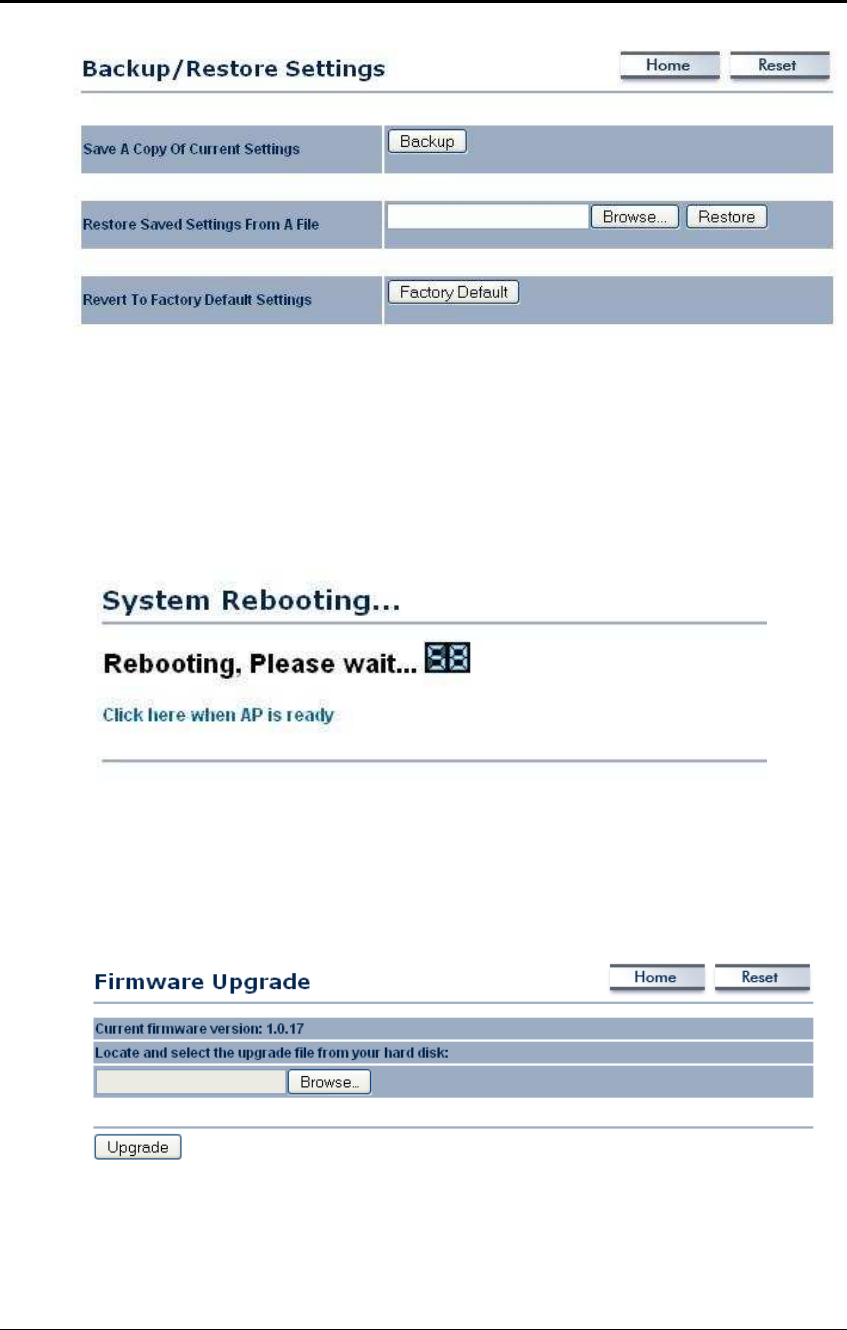
Long Range Wireless Access Point / Client Bridge Version 1.0
36
Save a copy of the current settings: Click on the Backup button to save the current
configuration.
Restore saved settings from a file: Once a file has been backed up, you may
restore it by clicking on the Browse button to select the file, and then the Restore
button.
Revert to factory default settings: Click on the Factory Default Settings button to
reset the device to the default settings. Please wait while the device restart and then
access the device using the default IP address: 192.168.1.1
5.5.4 Firmware Upgrade
Click on the Upgrade Firmware link under the Management menu. This page is
used to upgrade the firmware on the device. Make sure that downloaded the
appropriate firmware from your vendor.
Click on the Browse button and then select the appropriate firmware and then click
on the Upgrade button.
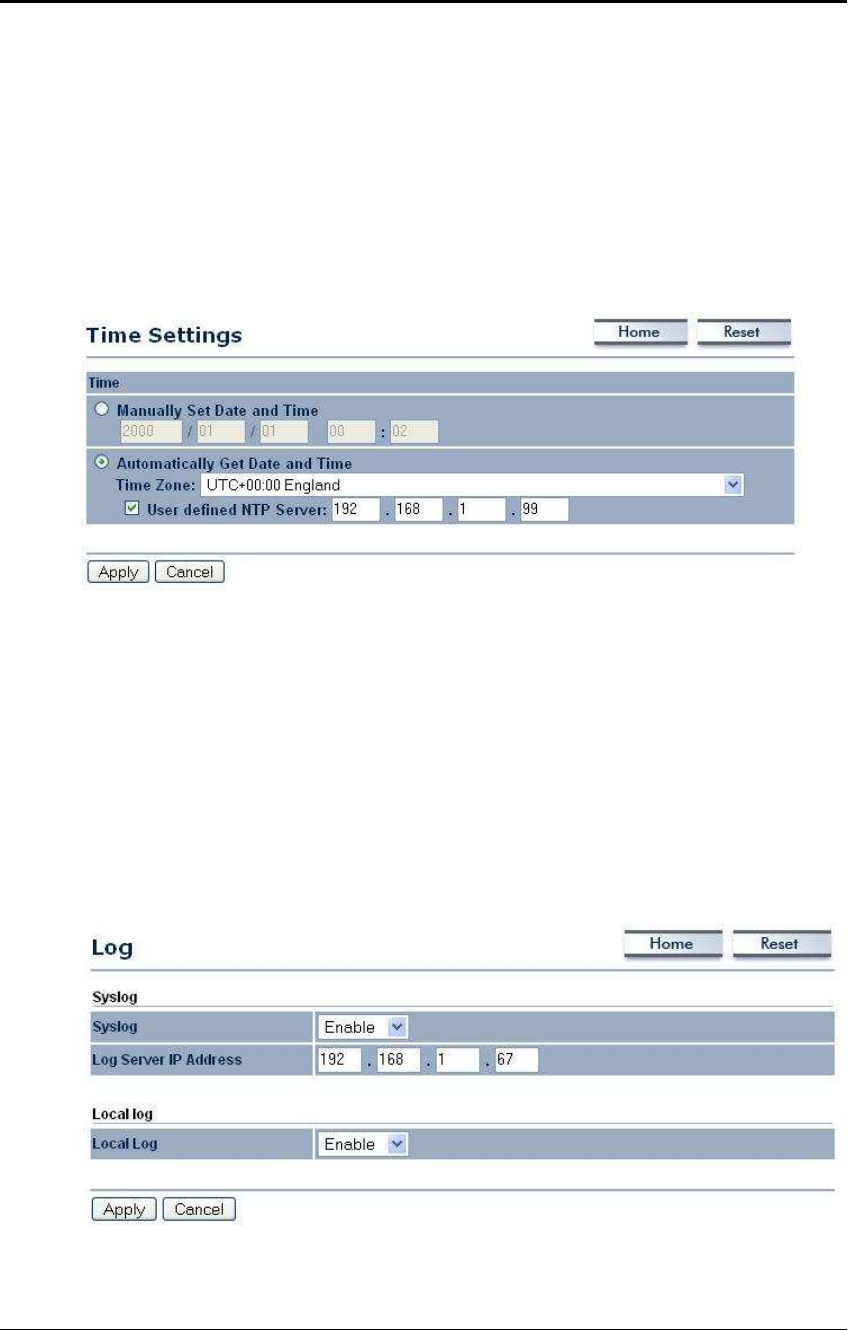
Long Range Wireless Access Point / Client Bridge Version 1.0
37
Note: The upgrade process may take about 1 minute to complete. Do not power off
the device during this process as it may crash the device and make it unusable. The
device will restart automatically once the upgrade is complete.
5.5.5 Time Settings
Click on the Time Settings link under the Management menu. This page allows you
to configure the time on the device. You may do this manually or by connecting to a
NTP server.
Manually Set Date and Time: Specify the date and time
Automatically Get Date and Time: Select the time zone from the drop down list and
then specify the IP address of the NTP server.
Click on the Apply button to save the changes.
5.5.6 Log
Click on the Log link under the Management menu. The Log page displays a list of
events that are triggered on the Ethernet and Wireless interface. This log can be
referred when an unknown error occurs on the system or when a report needs to be
sent to the technical support department for debugging purposes.
Syslog: Choose to enable or disable the system log.

Long Range Wireless Access Point / Client Bridge Version 1.0
38
Log Server IP Address: Specify the IP address of the server that will receive the
system log.
Local Log: Choose to enable or disable the local log.
Click on the Apply button to save the changes.
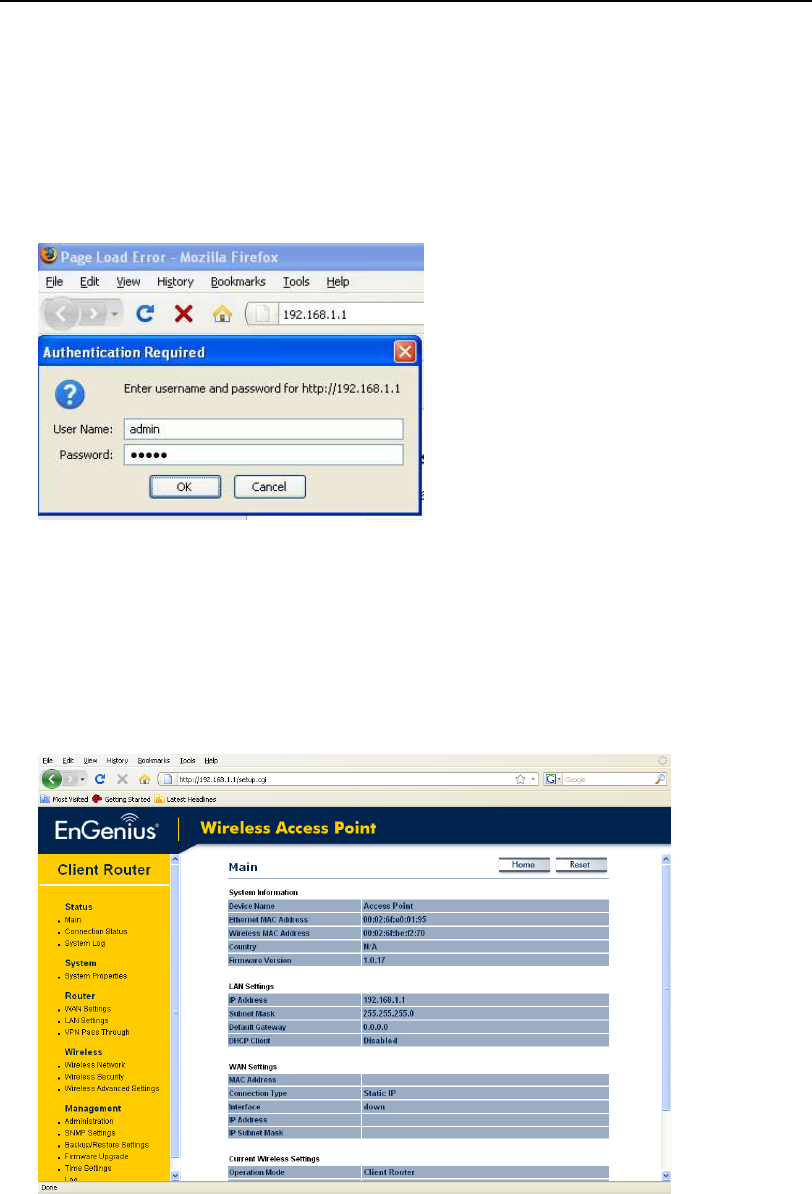
6 Client Router Operating Mode
6.1 Logging In
To configure the device through the web-browser, enter the IP address of the device
(default: 192.168.1.1) into the address bar of the web-browser and press Enter.
Make sure that the device and your computers are configured on the same subnet.
Refer to Chapter 2 in order to configure the IP address of your computer.
After connecting to the IP address, the web-browser will display the login page.
Specify admin for both the user name and password.
After logging in you will graphical user interface (GUI) of the device. The navigation
drop-down menu on left is divided into four sections:
1. Status: Displays the overall status, connection status, and event log.
2. System: This menu includes the system properties, IP and Spanning Tree settings.
3. Router: This includes WAN, LAN, and VPN settings.
4. Wireless: This menu includes status, basic, advanced, and security.
5. Management: This menu includes the admin setup, SNMP, firmware upgrade, and
save/restore backup.
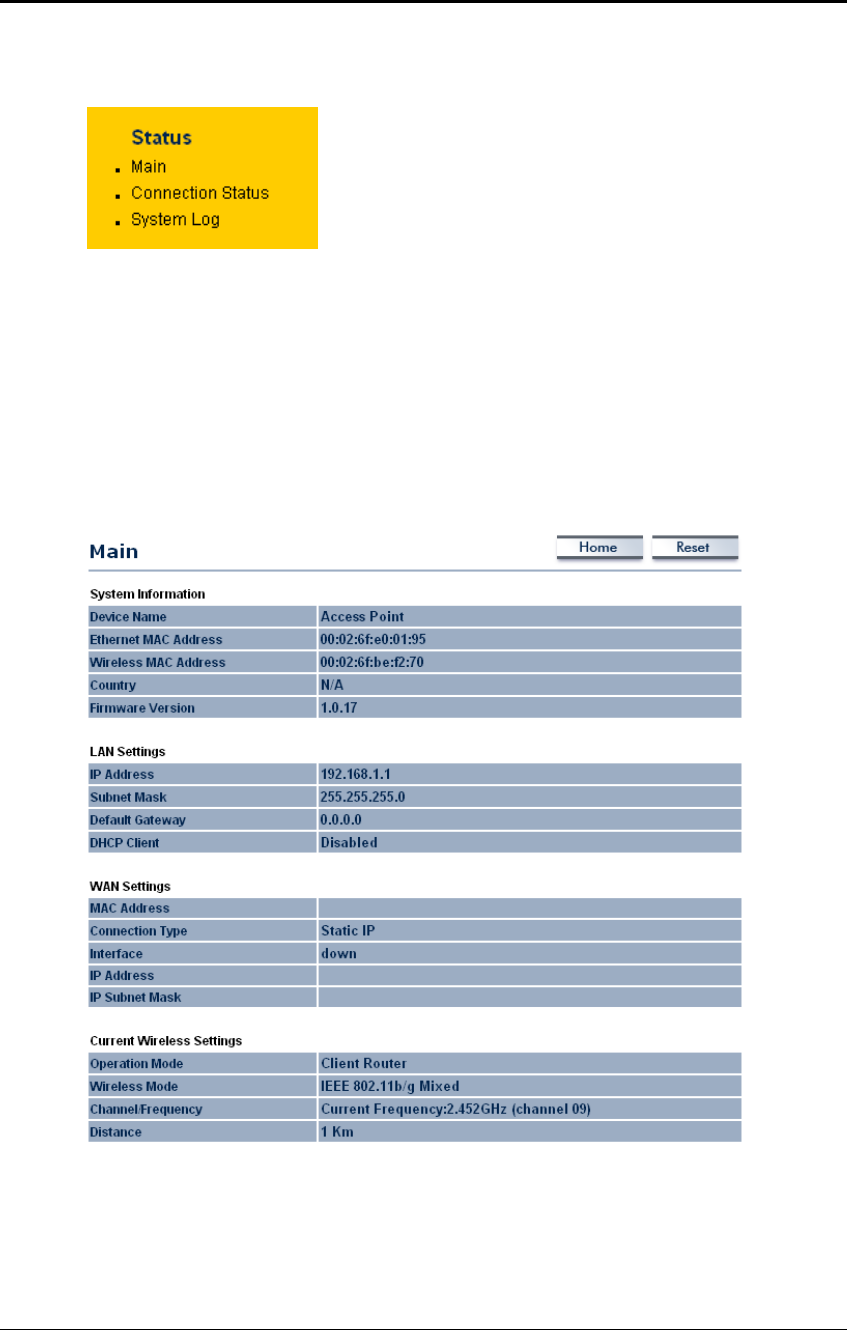
Long Range Wireless Access Point / Client Bridge Version 1.0
40
6.2 Status
Click on the Status link on the navigation
drop-down menu. You will then see three
options: Main, Connection Status, and System
Log. Each option is described in detail below.
6.2.1 Main
Click on the Main link under the Status drop-down menu. The status that is
displayed corresponds with the operating mode that is selected. Information such as
system up time, firmware version, serial number, kernel version and application
version are displayed in the ‘System’ section. LAN IP address, subnet mask, and
MAC address are displayed in the ‘System’ section. In the ‘Wireless section, the
frequency, channel is displayed. The ‘WAN” section displays the MAC address,
connection type, interface, IP address, and subnet mask.
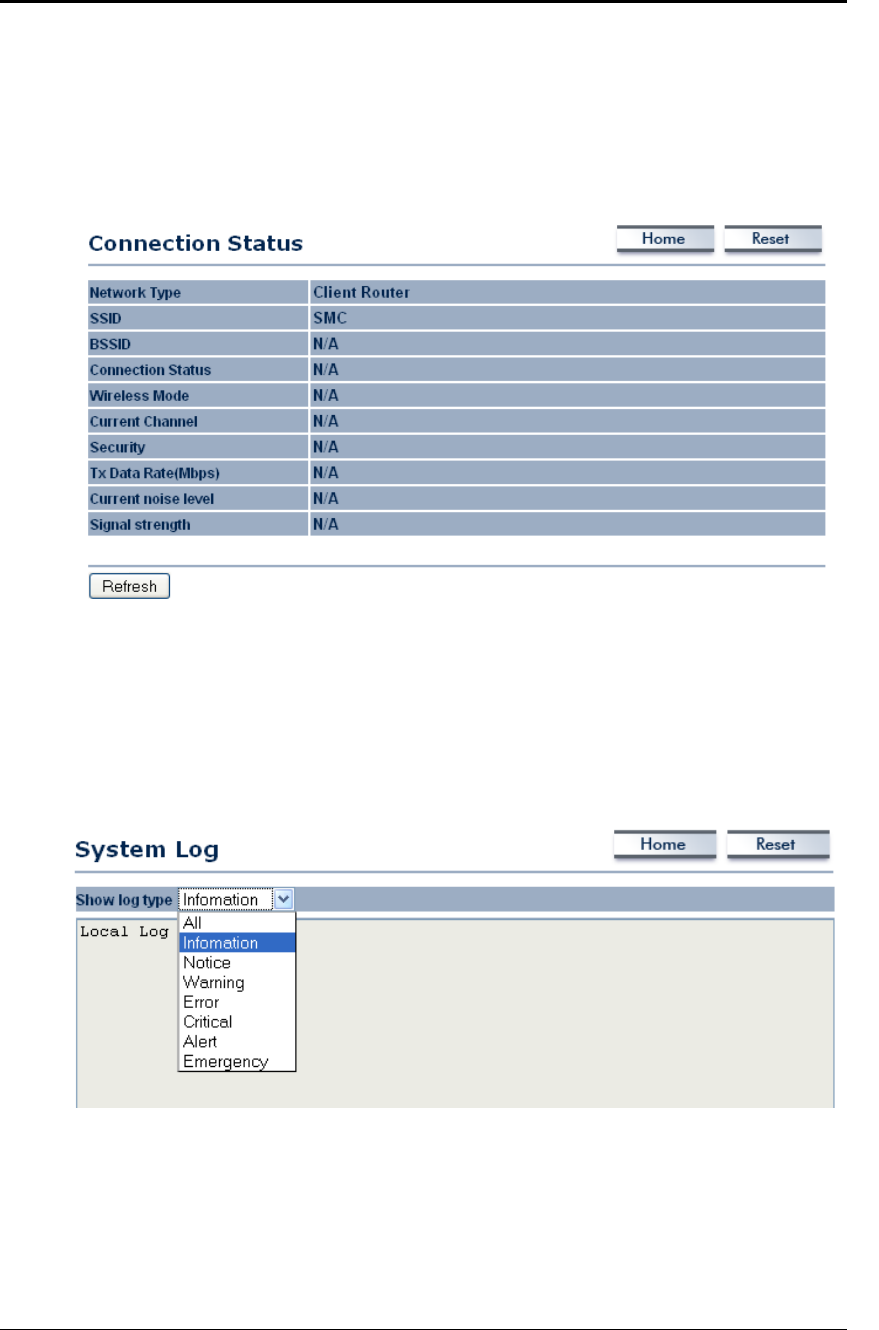
Long Range Wireless Access Point / Client Bridge Version 1.0
41
6.2.2 Connection Status
Click on the Connection Status link under the Status drop-down menu. This page
displays the current status of the network, including network type, SSID, BSSID,
connection status, wireless mode, current channel, security, data rate, noise level
and signal strength.
6.2.3 System Log
Click on the System Log link under the Status drop-down menu. The device
automatically logs (records) events of possible interest in its internal memory. If there
is not enough internal memory for all events, logs of older events are deleted, but
logs of the latest events are retained.
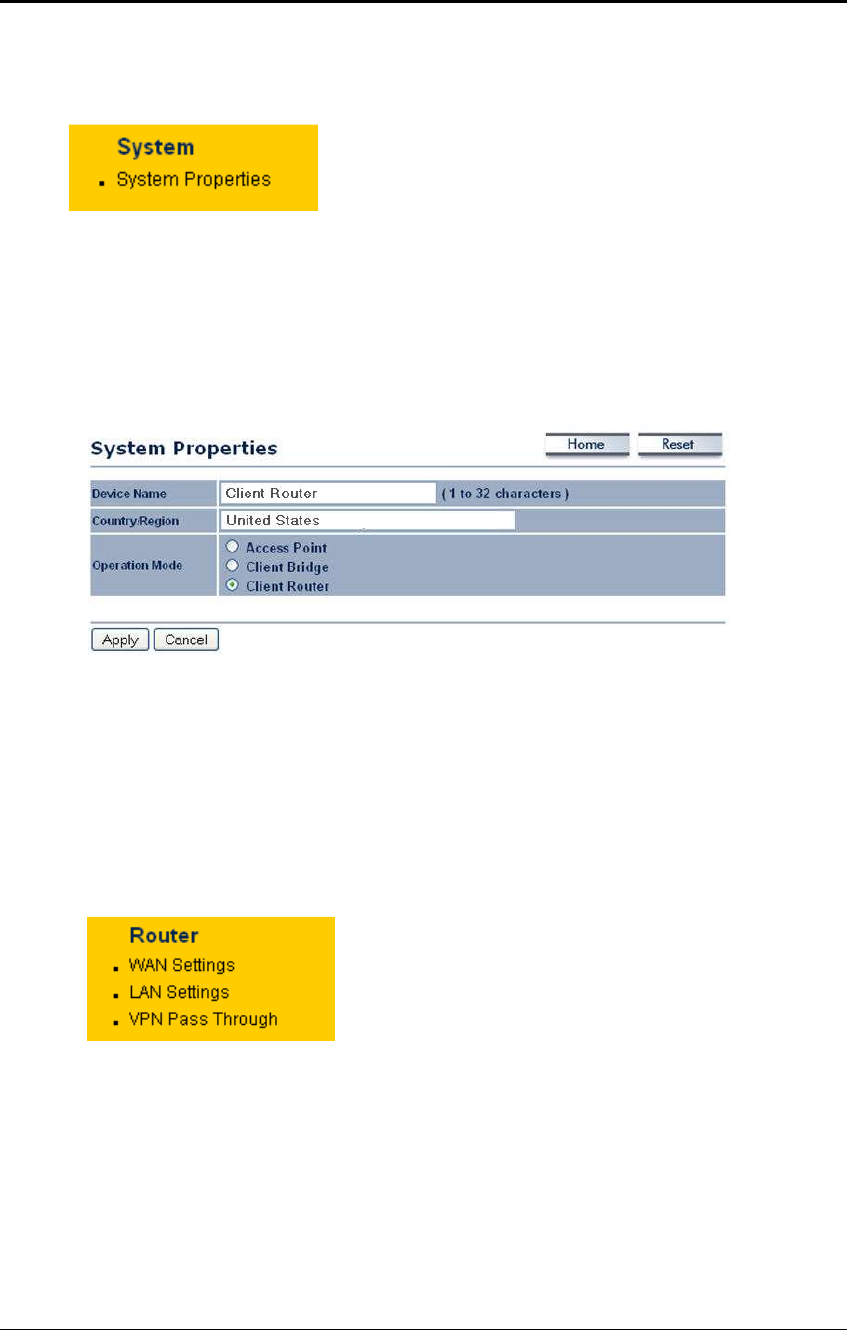
Long Range Wireless Access Point / Client Bridge Version 1.0
42
6.3 System
Click on the System link on the navigation
drop-down menu. You will then see System
Properties setting, which is described below.
6.3.1 System Properties
Click on the System Properties link under the System drop-down menu. This page
allows you to switch the operating mode of the device, as well as specify a name and
select the operating region.
Device Name: Specify a name for the device (this is not the SSID),
Country/Region: United States.
Operating Mode: Select and operating mode. Configuration for each operating
mode is described in their respective chapters.
Click on the Apply button to save the changes.
6.4 Router
Click on the Router link on the navigation
drop-down menu. You will then see three
options: WAN settings, LAN settings, and
VPN Pass Through. Each section is
described in detail below.
6.4.1 WAN Settings
Click on the WAN Settings link under the Router drop-down menu. This page allows
you to configure the WAN interface as DHCP, Static IP, or PPPoE.
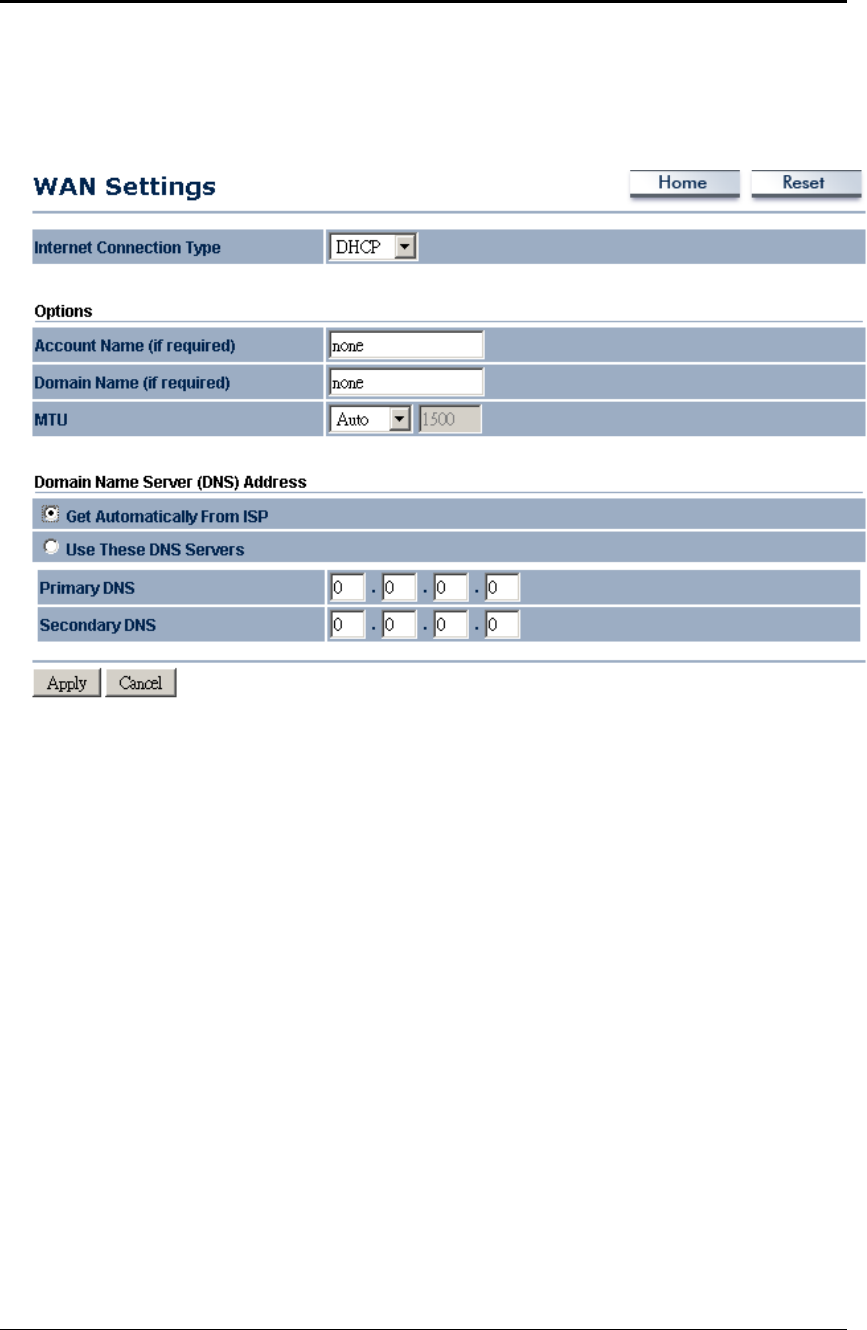
Long Range Wireless Access Point / Client Bridge Version 1.0
43
6.4.1.1 WAN - DHCP
The WAN interface can be configured as a DHCP Client in which the ISP provides
the IP address to the device. This is also known as Dynamic IP.
Internet Connection Type: Select the DHCP from the drop-down list.
Account Name: Specify an account name if your ISP has provided you with one.
Domain Name: Specify a domain name if the ISP has provided you with one.
MTU: The Maximum Transmission Unit (MTU) is a parameter that determines the
largest packet size (in bytes) that the router will send to the WAN. If LAN devices
send larger packets, the router will break them into smaller packets. Ideally, you
should set this to match the MTU of the connection to your ISP. Typical values are
1500 bytes for an Ethernet connection and 1492 bytes for a PPPoE connection. If the
router's MTU is set too high, packets will be fragmented downstream. If the router's
MTU is set too low, the router will fragment packets unnecessarily and in extreme
cases may be unable to establish some connections. In either case, network
performance can suffer.
Domain Name Service: Select Get Automatically from ISP if the ISP will provide
the DNS address, if not, select Use these DNS servers and specify the primary and
secondary DNS server IP address.
Click on the Apply button to save the changes.
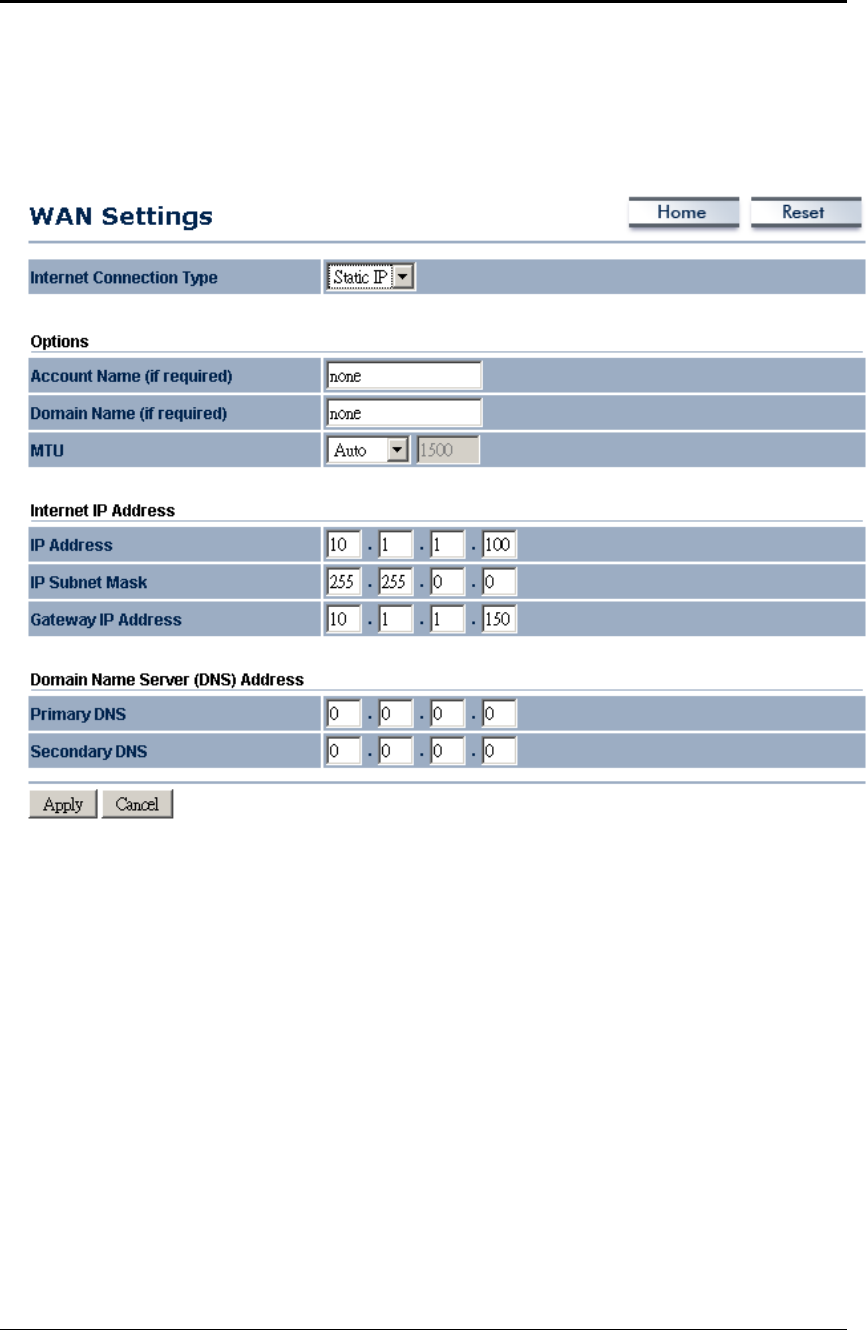
Long Range Wireless Access Point / Client Bridge Version 1.0
44
6.4.1.2 WAN – Static IP
The WAN interface can be configured as Static IP address. In this type of connection,
your ISP provides you with a dedicated IP address (which does not change as
DHCP).
Internet Connection Type: Select the Static IP from the drop-down list.
Account Name: Specify an account name if your ISP has provided you with one.
Domain Name: Specify a domain name if the ISP has provided you with one.
MTU: The Maximum Transmission Unit (MTU) is a parameter that determines the
largest packet size (in bytes) that the router will send to the WAN. If LAN devices
send larger packets, the router will break them into smaller packets. Ideally, you
should set this to match the MTU of the connection to your ISP. Typical values are
1500 bytes for an Ethernet connection and 1492 bytes for a PPPoE connection. If the
router's MTU is set too high, packets will be fragmented downstream. If the router's
MTU is set too low, the router will fragment packets unnecessarily and in extreme
cases may be unable to establish some connections. In either case, network
performance can suffer.
IP Address: Specify the IP address for this device, which is assigned by your ISP.
Subnet Mask: Specify the subnet mask for this IP address, which is assigned by
your ISP.
Default Gateway: Specify the IP address of the default gateway, which is assigned
by your ISP.
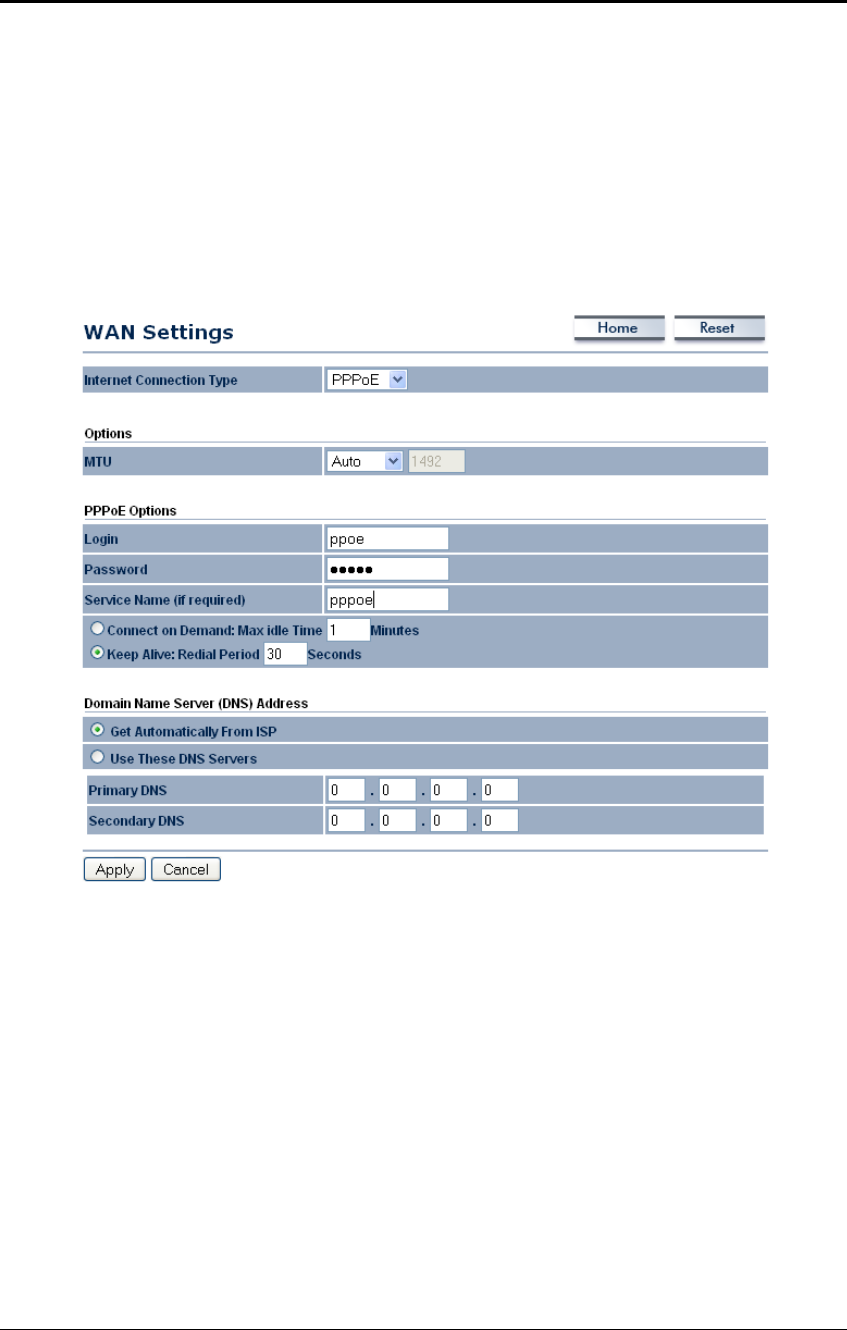
Long Range Wireless Access Point / Client Bridge Version 1.0
45
Domain Name Service: Select Get Automatically from ISP if the ISP will provide
the DNS address, if not, select Use these DNS servers and specify the primary and
secondary DNS server IP address.
Click on the Apply button to save the changes.
6.4.1.3 WAN – PPPoE
The WAN interface can be configured as PPPoE. This type of connection is usually
used for a DSL service and requires a username and password to connect.
Internet Connection Type: Select PPPoE from the drop-down list.
MTU: The Maximum Transmission Unit (MTU) is a parameter that determines the
largest packet size (in bytes) that the router will send to the WAN. If LAN devices
send larger packets, the router will break them into smaller packets. Ideally, you
should set this to match the MTU of the connection to your ISP. Typical values are
1500 bytes for an Ethernet connection and 1492 bytes for a PPPoE connection. If the
router's MTU is set too high, packets will be fragmented downstream. If the router's
MTU is set too low, the router will fragment packets unnecessarily and in extreme
cases may be unable to establish some connections. In either case, network
performance can suffer.
Login: Specify the user name which is provided by your ISP.
Password: Specify the password which is provided by your ISP, and then verify it
once again in the next field.
Service Name: Specify the name of the ISP.
Type: Select a reconnection type: Keep Alive (A connection to the Internet is
always maintained), Connect on Demand: You have to open up the Web-based
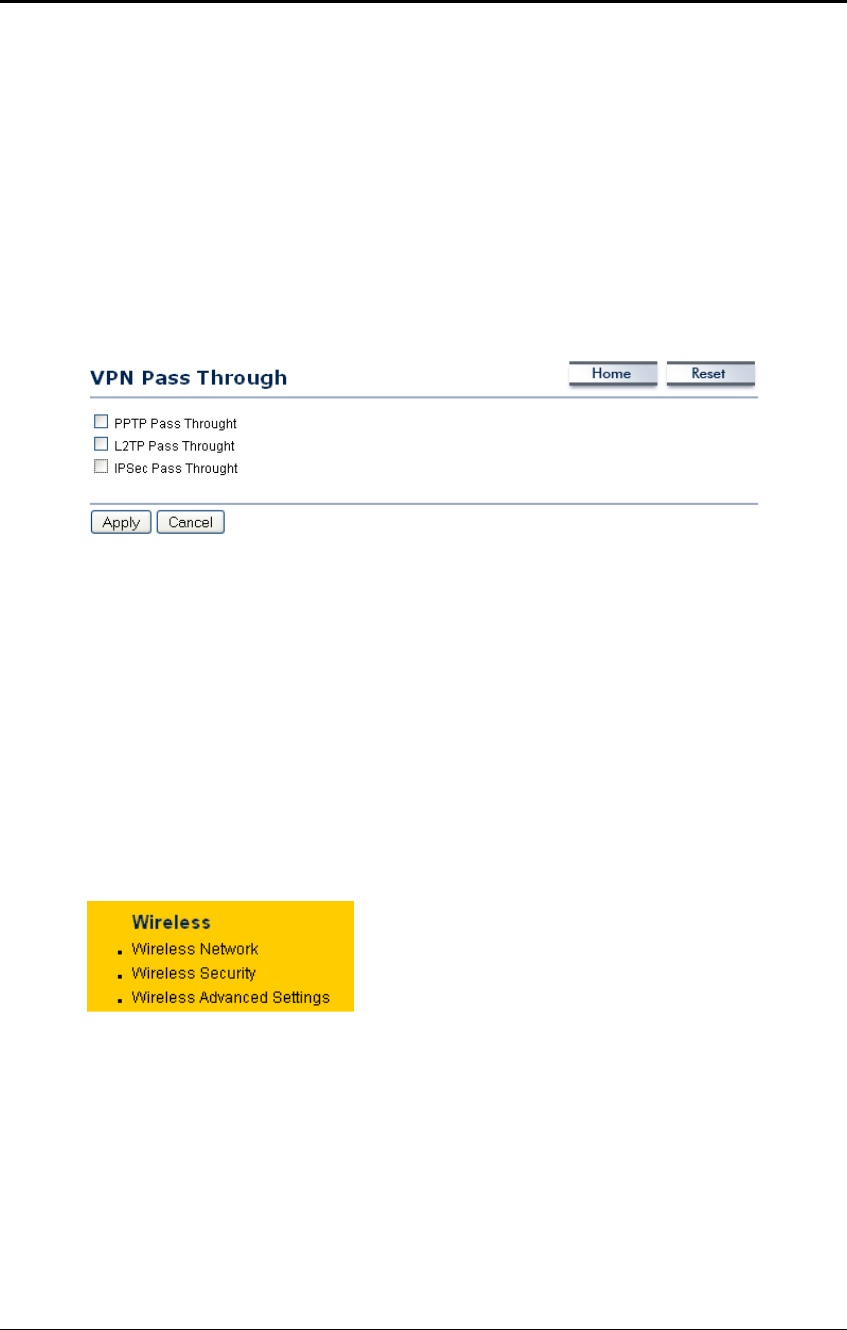
Long Range Wireless Access Point / Client Bridge Version 1.0
46
management interface and click the Connect button manually any time that you wish
to connect to the Internet.
Domain Name Service: Select Get Automatically from ISP if the ISP will provide
the DNS address, if not, select Use these DNS servers and specify the primary and
secondary DNS server IP address.
Click on the Apply button to save the changes.
6.4.2 VPN Pass Through
Click on the VPN Pass Through link under the Router drop-down menu. This page
allows you to enable the pass through feature.
PPTP Pass Through: Place a check in this box if you would like to enable this pass
through. PPTP is a protocol (set of communication rules) that allows corporations to
extend their own corporate network through private "tunnels"
L2TP Pass Through: Place a check in this box if you would like to enable this pass
through. Layer 2 Tunneling Protocol is a transport protocol that enables tunneling
through the Internet for the establishment of virtual private networks.
IPSec Pass Through: Place a check in this box if you would like to enable this pass
through. IPSec is a VPN protocol used to implement secure exchange of packets at
the IP layer.
Click on the Apply button to save the changes.
6.5 Wireless
Click on the Wireless link on the
navigation drop-down menu. You will
then see three options: wireless network,
wireless security, and wireless
advanced settings. Each option is
described below.
6.5.1 Wireless Network
The Wireless Network page allows you to configure the wireless mode, channel,
SSID, and security settings.
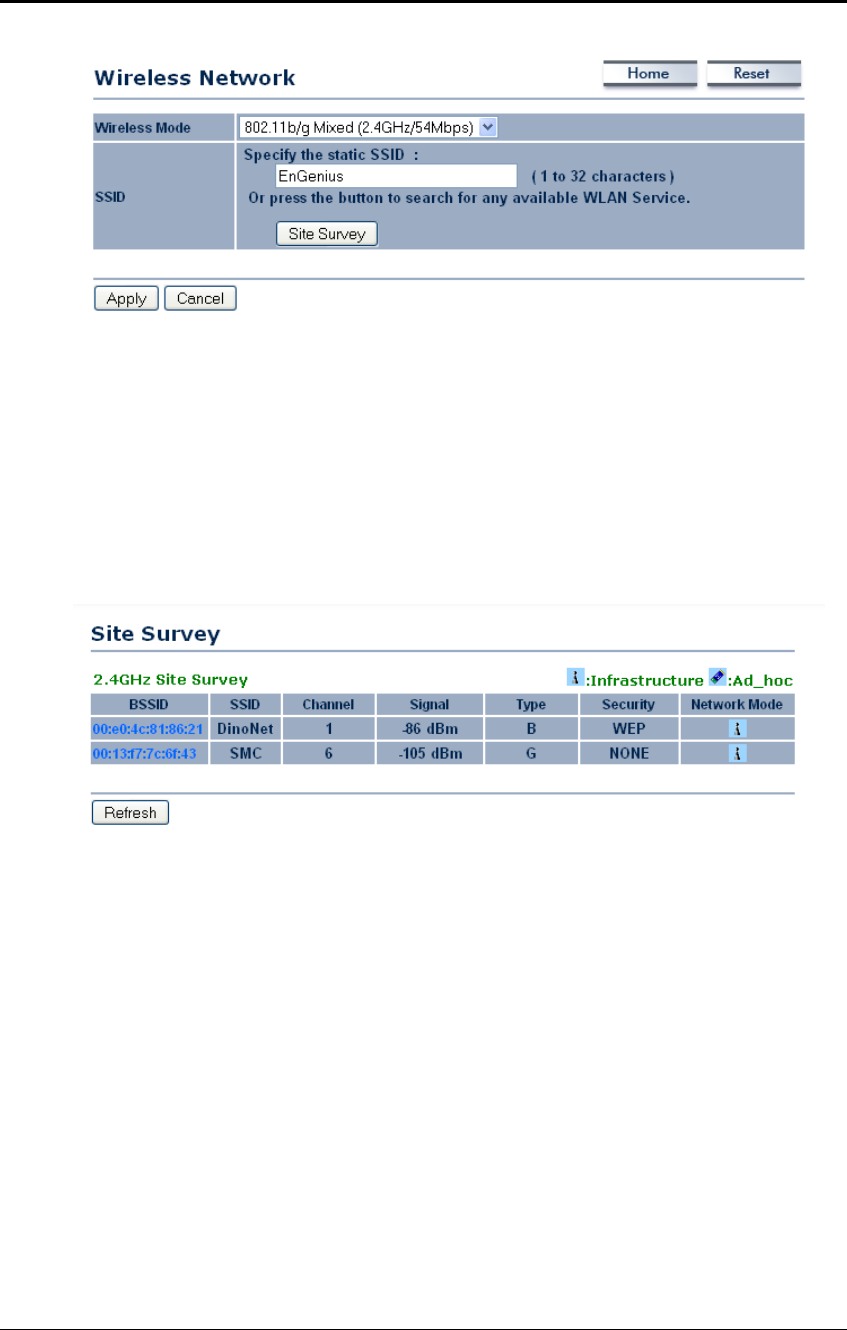
Long Range Wireless Access Point / Client Bridge Version 1.0
47
Wireless Mode: Depending on the type of wireless clients that are connected to the
network, you may select B, G, or B/G-mixed. If you are not sure about which clients
will be accessing the wireless networks, it is recommended that you select B/G-
mixed for the best performance.
SSID: The SSID is a unique named shared amongst all the points of the wireless
network. The SSID must be identical on all points of the wireless network and cannot
exceed 32 characters. You may specify an SSID or select one from the Site Survey.
Site Survey: Click on the Site Survey button in order to scan the 2.4GHz frequency
for devices that broadcast their SSID. Click on the BSSID link to connect to the
Access Point. Click on the Refresh button to re-scan the frequency.
6.5.1.1 Wireless Security - WEP
Security Mode: Select WEP from the drop-down list if your wireless network uses
WEP encryption. WEP is an acronym for Wired Equivalent Privacy, and is a security
protocol that provides the same level of security for wireless networks as for a wired
network.
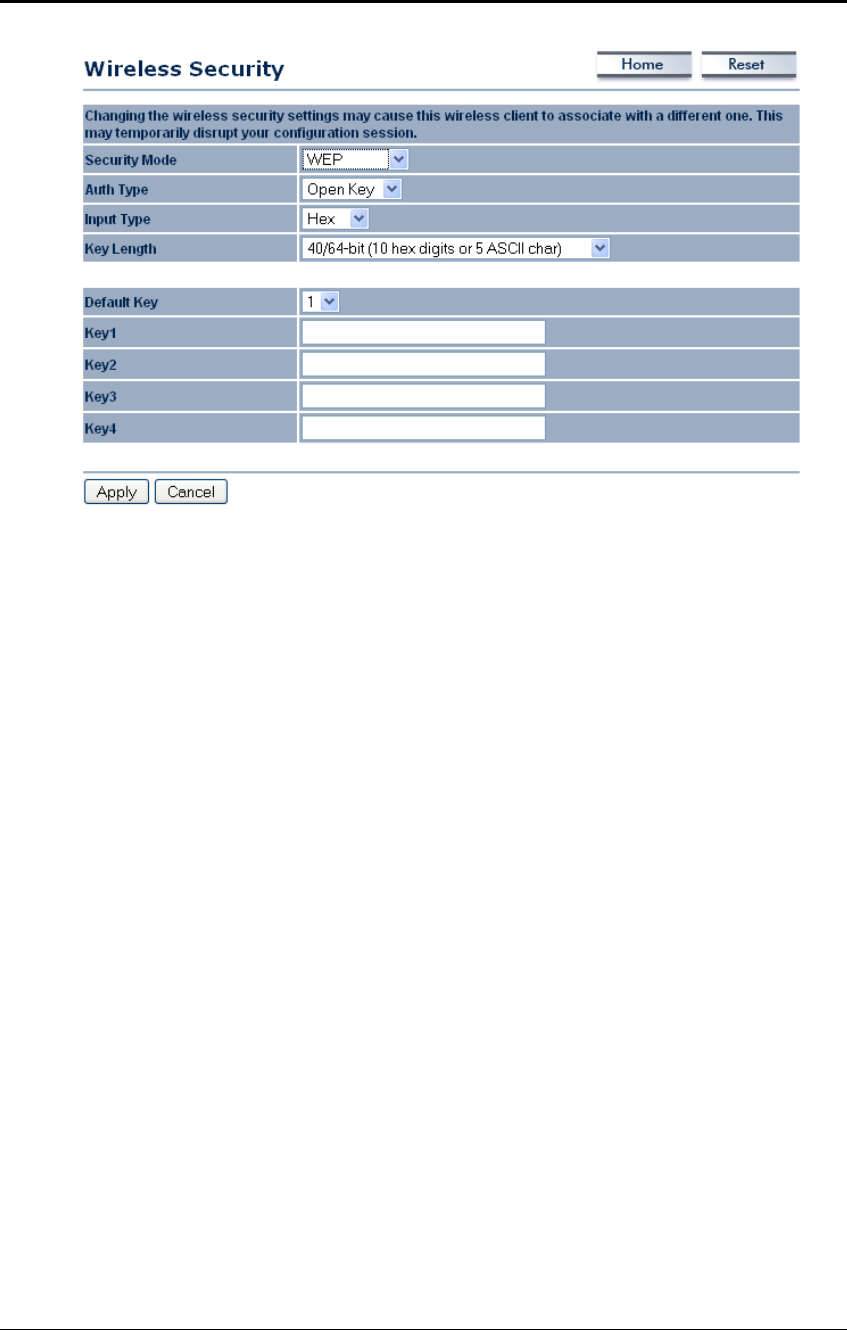
Long Range Wireless Access Point / Client Bridge Version 1.0
48
Authentication Type: Select an authentication method. Options available are Open
Key, Shared Key. An open system allows any client to authenticate as long as it
conforms to any MAC address filter policies that may have been set. All
authentication packets are transmitted without encryption. Shared Key sends an
unencrypted challenge text string to any device attempting to communicate with the
Access Point. The device requesting authentication encrypts the challenge text and
sends it back to the Access Point. If the challenge text is encrypted correctly, the
Access Point allows the requesting device to authenticate. It is recommended to
select Auto if you are not sure which authentication type is used.
Input Type: Select Hex or ASCII from the drop-down list
Key Length: Select a key format from the drop-down list. 64bit-hex keys require 10
characters, where as 128-bit keys require 26 characters. A hex key is defined as a
number between 0 through 9 and letter between A through F and a through f.
Default Key: You may use up to four different keys for four different networks. Select
the current key that will be used.
Key 1-4: You may enter four different WEP keys.
Click on the Apply button to save the changes.
6.5.1.2 Wireless Security – WPA-PSK, WPA2-PSK,
Security Mode: Select WPA-PSK, or WPA2-PSK from the drop-down list if your
wireless network uses WPA pre-shared key.
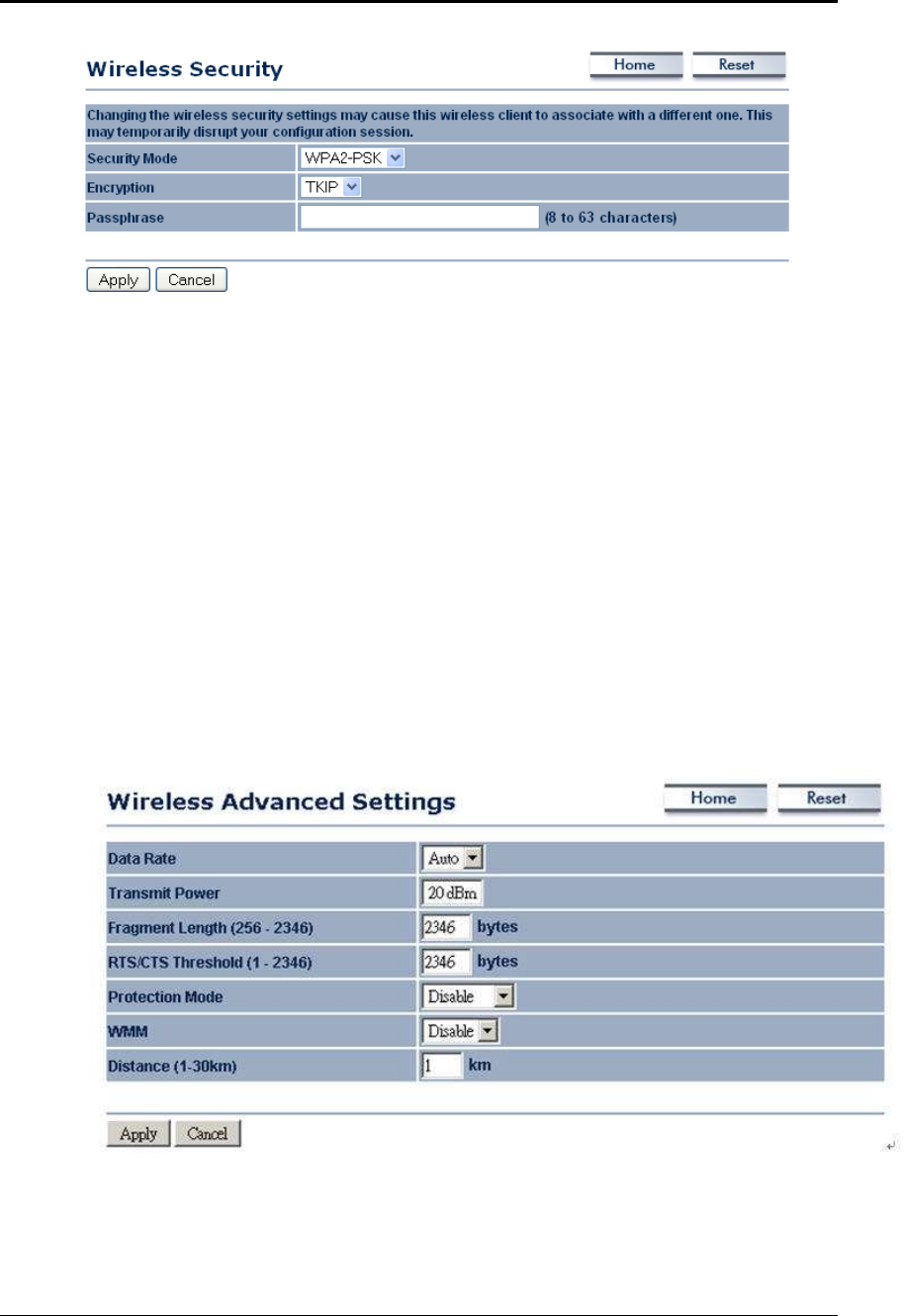
Long Range Wireless Access Point / Client Bridge Version 1.0
49
Encryption: Select TKIP or AES from the drop-down list if your wireless network
uses this encryption. WPA (Wi-Fi Protected Access) was designed to improve upon
the security features of WEP (Wired Equivalent Privacy). The technology is designed
to work with existing Wi-Fi products that have been enabled with WEP. WPA
provides improved data encryption through the Temporal Integrity Protocol (TKIP),
which scrambles the keys using a hashing algorithm and by adding an integrity
checking feature which makes sure that keys haven’t been tampered with.
Passphrase: Specify a passphrase that is shared amongst the Access Points and
clients.
Click on the Apply button to save the changes.
6.5.2 Wireless Advanced Settings
Click on the Wireless Advanced Settings link. On this page you can configure the
advanced settings to tweak the performance of your wireless network. Options
available are: data rate, transmit power, fragmentation threshold, RTS threshold,
protection mode and distance.
Data Rate: If you would like to force a data rate, you may select one from the drop-
down list. However, for best performance it is recommended to use the Auto setting.
Transmit Power: Regular Power.
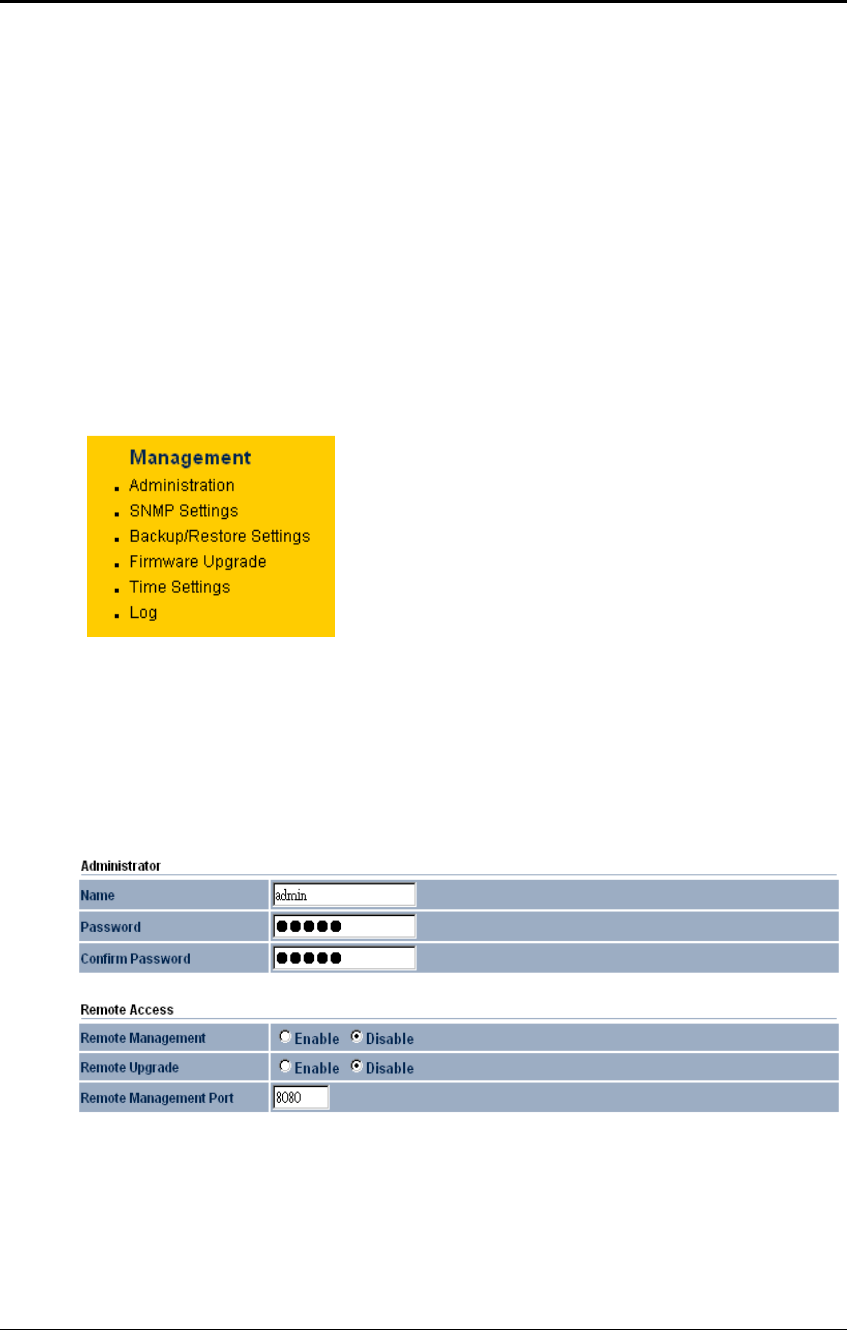
Long Range Wireless Access Point / Client Bridge Version 1.0
50
Fragment: Packets over the specified size will be fragmented in order to improve
performance on noisy networks.
RTS Threshold: Packets over the specified size will use the RTS/CTS mechanism to
maintain performance in noisy networks and preventing hidden nodes from
degrading the performance.
Protection Mode: If your wireless network is using both 802.11b and 802.g devices
then it is recommended to enable this feature so that the 802.11b devices will not
degrade the performance of 802.11g devices.
WMM: Enable wireless Quality of Service
Distance (1-30km): Specify a distance between 1 and 30Km.
Click on the Apply button to save the changes.
6.6 Management
Click on the Management link on the
navigation drop-down menu. You will then
see six options: administration, SNMP
settings, backup/restore settings, firmware
upgrade, time settings, and log. Each option
is described below.
5.5.7 Administration
Click on the Administration link under the Management menu. This option allows
you to create a user name and password for the device. By default, this device is
configured without a user name and password admin. For security reasons it is
highly recommended that you create a new user name and password.
Name: Specify a user name into the first field.
Password: Specify a password into this field and then re-type the password into the
Confirm Password field.
Remote Management: Choose to enable or disable remote management.
Remote Upgrade: Choose to enable or disable remote firmware upgrade.
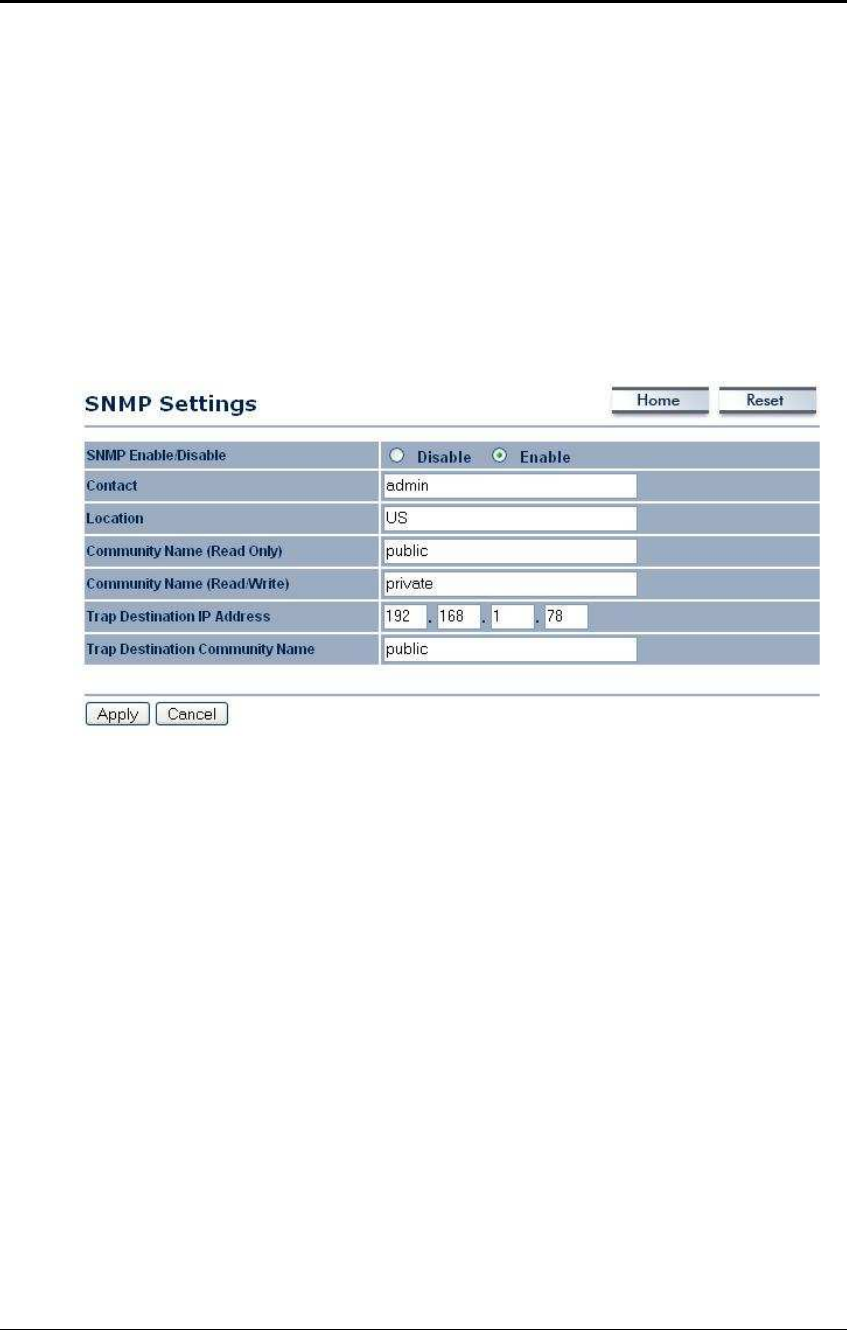
Long Range Wireless Access Point / Client Bridge Version 1.0
51
Remote Management Port: Specify a port for remote management. For example, if
you specify 8080, then you will need to specify <IP address>:<port>
192.168.1.1:8080 to connect to the web interface of the device.
Click on the Apply button to save the changes.
5.5.8 SNMP Settings
Click on the SNMP Settings link under the Management menu. This option allows
you to assign the contact details, location, and community name and trap settings for
SNMP. This is a networking management protocol used to monitor network-attached
devices. SNMP allows messages (called protocol data units) to be sent to various
parts of a network. Upon receiving these messages, SNMP-compatible devices
(called agents) return data stored in their Management Information Bases. .
SNMP Enable/Disable: Choose to enable or disable the SNMP feature.
Contact: Specify the contact details of the device.
Location: Specify the location of the device.
Read-Only Community Name: Specify the password for access the SNMP
community for read only access.
Read-Write Community Name: Specify the password for access to the SNMP
community with read/write access.
Send SNMP Trap: Specify the IP address of the computer that will receive the
SNMP traps.
Trap Community Name: Specify the password for the SNMP trap community.
Click on the Apply button to save the changes.
5.5.9 Backup/Restore settings, Reset to factory default settings
Click on the Backup/Restore Setting link under the Management menu. This option
is used to save the current settings of the device in a file on your local disk or load
settings on to the device from a local disk. This feature is very handy for
administrators who have several devices that need to be configured with the same
settings.
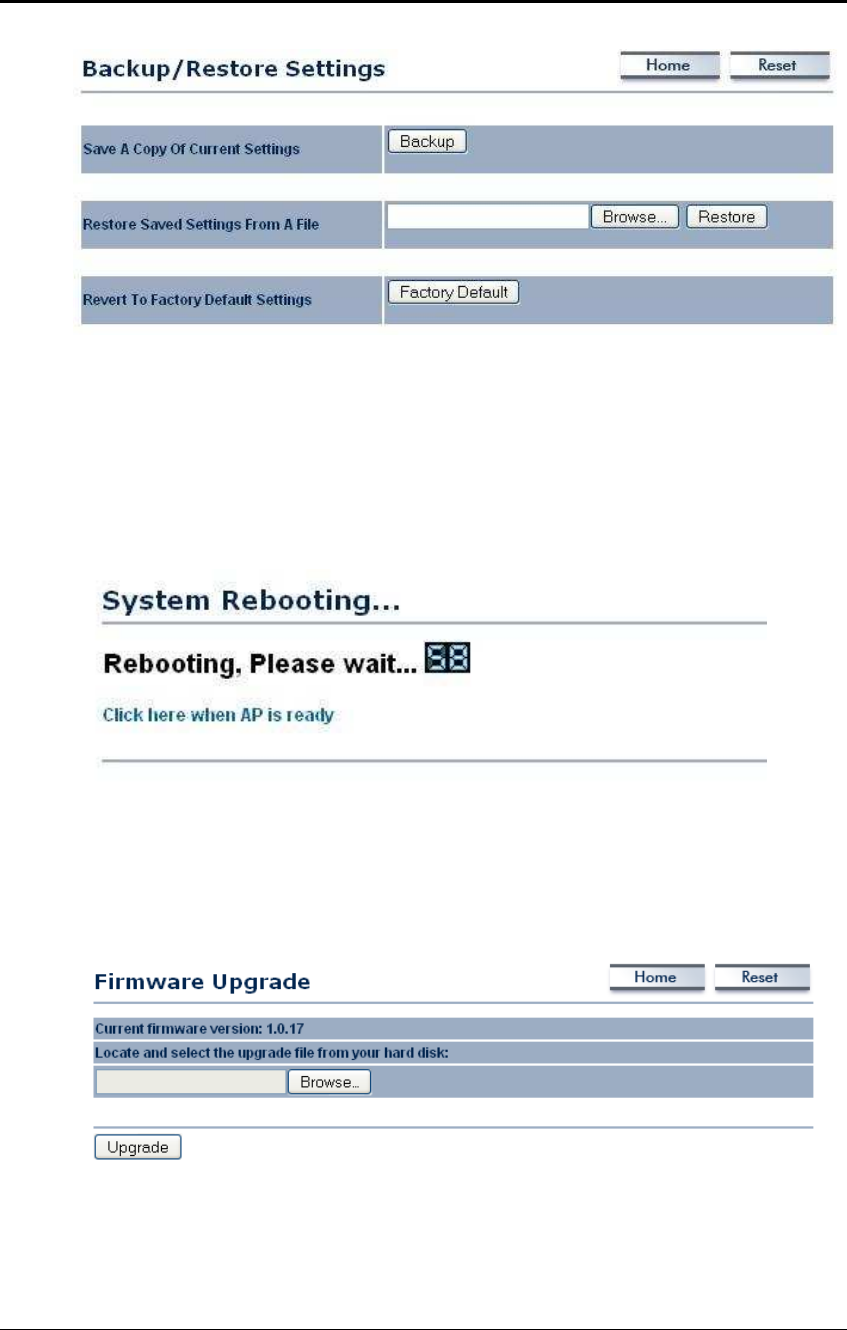
Long Range Wireless Access Point / Client Bridge Version 1.0
52
Save a copy of the current settings: Click on the Backup button to save the current
configuration.
Restore saved settings from a file: Once a file has been backed up, you may
restore it by clicking on the Browse button to select the file, and then the Restore
button.
Revert to factory default settings: Click on the Factory Default Settings button to
reset the device to the default settings. Please wait while the device restart and then
access the device using the default IP address: 192.168.1.1
5.5.10 Firmware Upgrade
Click on the Upgrade Firmware link under the Management menu. This page is
used to upgrade the firmware on the device. Make sure that downloaded the
appropriate firmware from your vendor.
Click on the Browse button and then select the appropriate firmware and then click
on the Upgrade button.
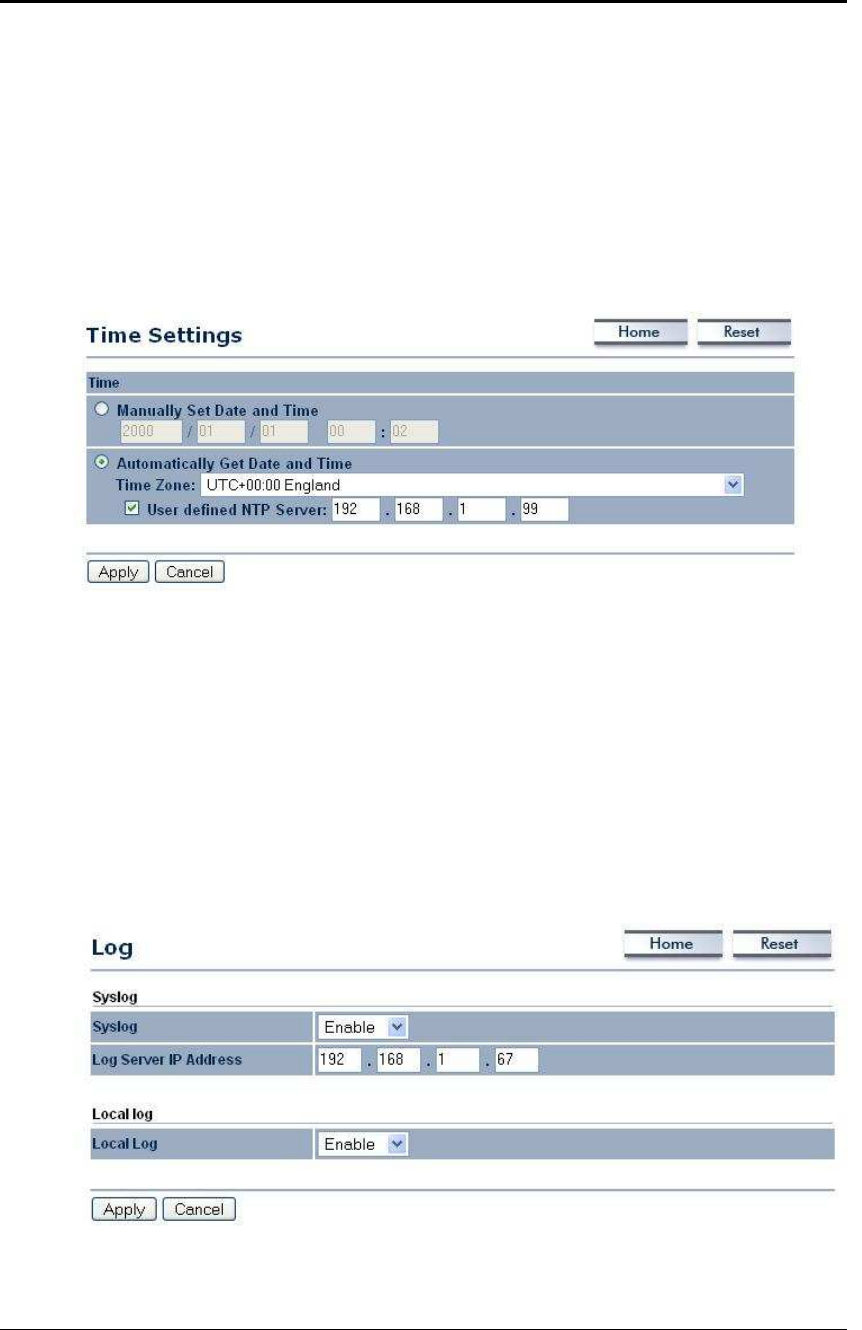
Long Range Wireless Access Point / Client Bridge Version 1.0
53
Note: The upgrade process may take about 1 minute to complete. Do not power off
the device during this process as it may crash the device and make it unusable. The
device will restart automatically once the upgrade is complete.
5.5.11 Time Settings
Click on the Time Settings link under the Management menu. This page allows you
to configure the time on the device. You may do this manually or by connecting to a
NTP server.
Manually Set Date and Time: Specify the date and time
Automatically Get Date and Time: Select the time zone from the drop down list and
then specify the IP address of the NTP server.
Click on the Apply button to save the changes.
5.5.12 Log
Click on the Log link under the Management menu. The Log page displays a list of
events that are triggered on the Ethernet and Wireless interface. This log can be
referred when an unknown error occurs on the system or when a report needs to be
sent to the technical support department for debugging purposes.
Syslog: Choose to enable or disable the system log.

Long Range Wireless Access Point / Client Bridge Version 1.0
54
Log Server IP Address: Specify the IP address of the server that will receive the
system log.
Local Log: Choose to enable or disable the local log.
Click on the Apply button to save the changes.

Long Range Wireless Access Point / Client Bridge Version 1.0
55
Appendix A – FCC Interference Statement
Federal Communication Commission Interference Statement
This equipment has been tested and found to comply with the limits for a Class B digital
device, pursuant to Part 15 of the FCC Rules. These limits are designed to provide
reasonable protection against harmful interference in a residential installation. This
equipment generates, uses and can radiate radio frequency energy and, if not installed
and used in accordance with the instructions, may cause harmful interference to radio
communications. However, there is no guarantee that interference will not occur in a
particular installation. If this equipment does cause harmful interference to radio or
television reception, which can be determined by turning the equipment off and on, the
user is encouraged to try to correct the interference by one of the following measures:
- Reorient or relocate the receiving antenna.
- Increase the separation between the equipment and receiver.
- Connect the equipment into an outlet on a circuit different from that
to which the receiver is connected.
- Consult the dealer or an experienced radio/TV technician for help.
FCC Caution: Any changes or modifications not expressly approved by the party
responsible for compliance could void the user's authority to operate this equipment.
This device complies with Part 15 of the FCC Rules. Operation is subject to the following
two conditions: (1) This device may not cause harmful interference, and (2) this device
must accept any interference received, including interference that may cause undesired
operation.
IMPORTANT NOTE:
FCC Radiation Exposure Statement:
This equipment complies with FCC radiation exposure limits set forth for an uncontrolled
environment. This equipment should be installed and operated with minimum distance
20cm between the radiator & your body.
This transmitter must not be co-located or operating in conjunction with any other antenna
or transmitter.

Multi-Function Gigabit Wireless-N Client Bridge Version 1.0
56
Appendix B – IC Statement
Industry Canada statement:
This device complies with RSS-210 of the Industry Canada Rules. Operation is subject to the
following two conditions:
(1) This device may not cause harmful interference, and (2) this device must accept any
interference received, including interference that may cause undesired operation.
IMPORTANT NOTE:
Radiation Exposure Statement:
This equipment complies with IC radiation exposure limits set forth for an uncontrolled
environment. This equipment should be installed and operated with minimum distance 20cm
between the radiator & your body.
This device has been designed to operate with an antenna having a maximum gain of 5 dBi.
Antenna having a higher gain is strictly prohibited per regulations of Industry Canada. The
required antenna impedance is 50 ohms.